Tasmania is home to a diverse range of birdlife, with over 200 species found throughout the island. From towering eagles and majestic owls to tiny, brightly coloured parrots, Tasmania boasts an array of beautiful bird species that have adapted to its unique landscape and climate.
These birds are spread across various habitats, from the coastal regions to the forests, mountains, and wetlands that make up Tasmania’s diverse ecosystems.
For wildlife enthusiasts and birdwatchers, Tasmania has become a popular destination, offering opportunities to observe some of the world’s most stunning and rare bird species.
In this article, we will take a closer look at some of the fascinating birds that can be found in Tasmania, their behaviours, and what makes them unique.
1. Shorebirds
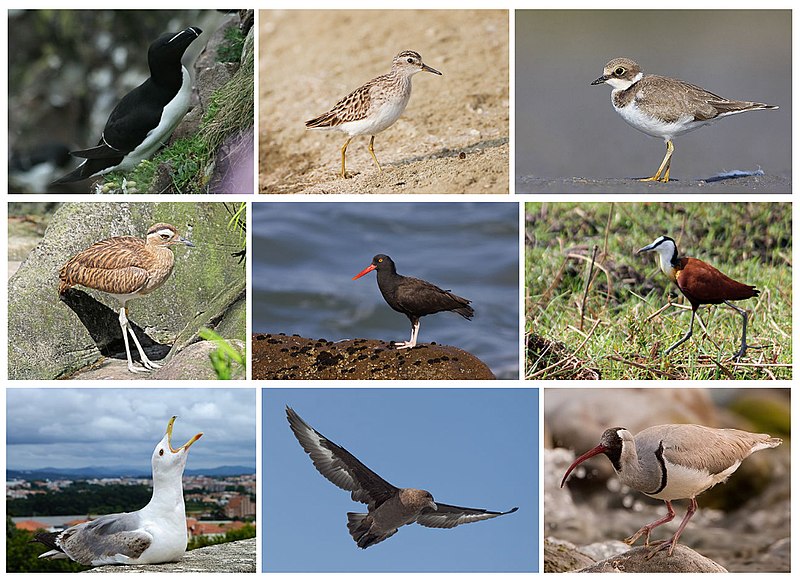
Shorebirds, a diverse group of birds in the Charadriiformes order, are found near water on every continent except Antarctica.
These small to medium-sized birds feed mainly on invertebrates and other small animals but can also be pelagic seabirds or inhabit deserts.
Shorebirds use their long bills to probe mudflats for food like worms and mollusks while some species plunge into the ocean’s depths in search of crustaceans such as crabs and shrimp.
They have strong legs equipped with webbed feet which allow them to move quickly when searching for prey across wetlands, sandbars, beaches and swamps.
Their feathers make them well adapted to life by land or sea due to its hydrophobic nature which helps reduce drag during swimming or flying through windy conditions making it easier for shorebirds survive tough environments around the world.Scientific classification:
| Kingdom | Animalia |
| Phylum | Chordata |
| Class | Aves |
| Infraclass | Neognathae |
| Clade | Neoaves |
| Clade | Gruimorphae |
| Order | Charadriiformes Huxley, 1867 |
Also Featured In: Beautiful Brazilian Birds, Turkey Birds You Should Know
2. White-Bellied Sea Eagle
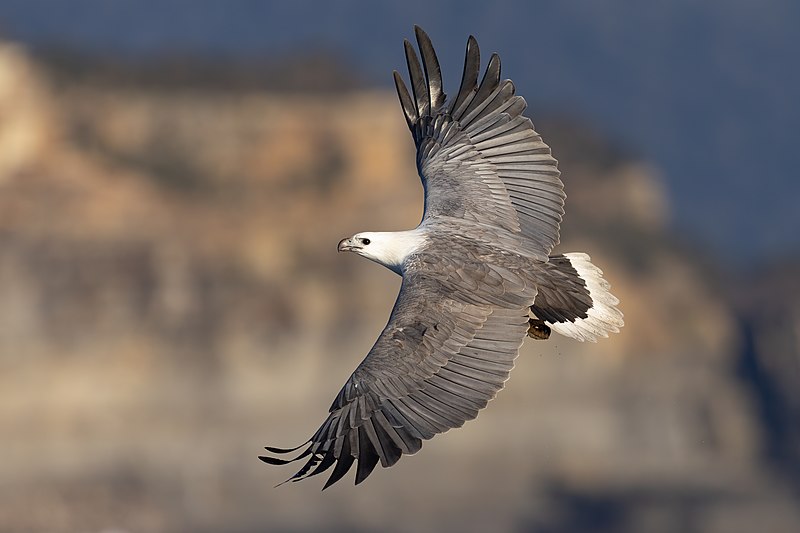
The White-bellied sea eagle is an impressive large bird of prey that belongs to the Accipitridae family.
It was first described by Johann Friedrich Gmelin in 1788 and it is closely related to Sanford’s sea eagle found in the Solomon Islands.
The adult white-bellied sea eagles have a stunning appearance with their white heads, dark brown bodies, and long wings which span up to 1.8 meters across.
They can be seen soaring above coastal areas searching for fish, reptiles or small birds as they hunt for food.
These majestic creatures are also known for being incredibly vocal when nesting – making loud cackling noises at dawn and dusk near riverside forests.Scientific classification:
| Kingdom | Animalia |
| Phylum | Chordata |
| Class | Aves |
| Order | Accipitriformes |
| Family | Accipitridae |
| Genus | Haliaeetus |
| Species | H. leucogaster |
Also Featured In: Most Common Types of Bangladeshi Birds, Urban Birds of Hong Kong
3. Frogmouth
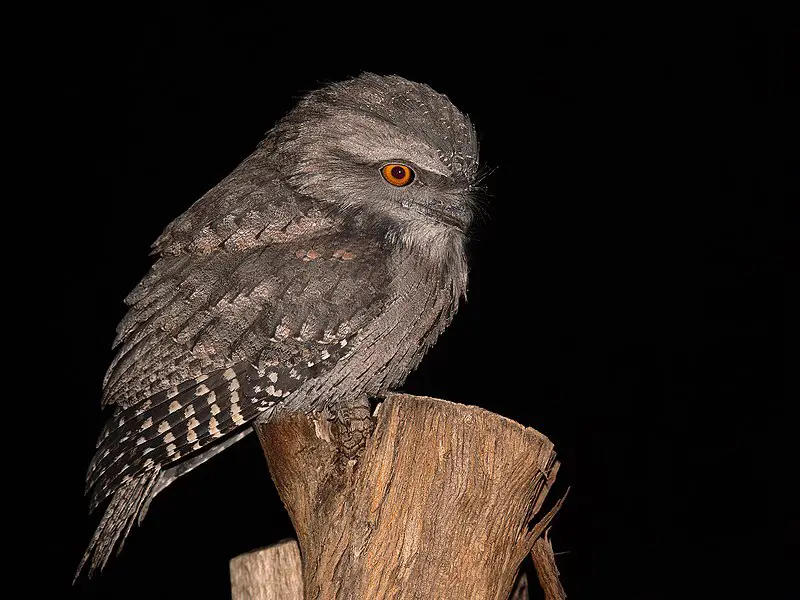
The Frogmouth is a nocturnal bird that belongs to the same family as owlet-nightjars, swifts and hummingbirds.
They have large flattened hooked bills with huge frog-like gape which helps them capture insects during night time.
Three species of Podargus are found in Australia and New Guinea only – they have massive eyes that allow for excellent night vision.
Their bodies are generally grey or brownish in colour with cryptic markings for camouflage when roosting during day light hours.
Generally known as quiet birds, their loud wailing call can be heard at dusk or dawn near river banks or wetlands where they live alone or form pairs throughout breeding season.
The diet of these fascinating creatures consists mainly of flying insects such as moths, beetles & cicadas etc., but on occasion will consume small vertebrates like lizards and frogs too.Scientific classification:
| Kingdom | Animalia |
| Phylum | Chordata |
| Class | Aves |
| Clade | Strisores |
| Order | Podargiformes Matthews, 1918 |
| Family | Podargidae Gray, 1847 |
Also Featured In: Birds of the Philippines, Asian Birds
4. Southern Giant Petrel
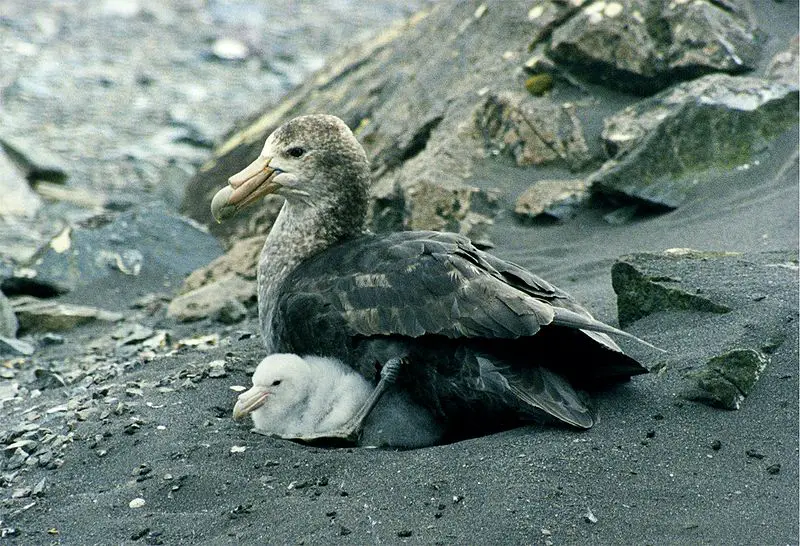
The Southern giant petrel is a large seabird native to the southern oceans, and it overlaps broadly with its similar counterpart, the Northern giant petrel.
Adults of both species can be distinguished by their bill-tip color: greenish in the south and yellowish in the north.
The Southern giant petrel also goes by other names such as Antarctic giant petrel, Giant fulmar, Stinker or Stinkpot.
These birds are around 75 cm (30 inches) long on average and have striking white plumage combined with brown wings that give them an impressive appearance while they soar through skies above open waters searching for food like fish, krill and squid – which they can catch up to 100 meters below sea level.Scientific classification:
| Kingdom | Animalia |
| Phylum | Chordata |
| Class | Aves |
| Order | Procellariiformes |
| Family | Procellariidae |
| Genus | Macronectes |
| Species | M. giganteus |
Also Featured In: Uganda Birds Species, Big Birds that Live in Uganda
5. Honeyeaters
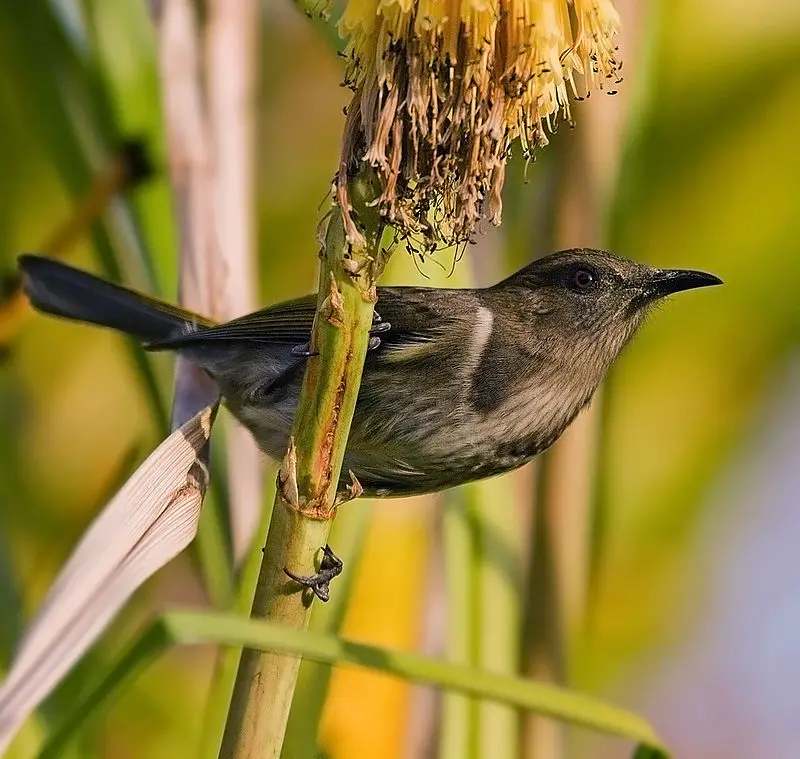
Honeyeaters are a unique and diverse family of birds, with species ranging in size from small to medium.
Found mainly in Australia and New Guinea, they can also be found as far east as Samoa and Tonga, or on islands such as Wallacea north or west of New Guinea.
Honeyeaters feed mainly on nectar but will consume insects if necessary for additional nutrition. They have specialized brush-like tongues that help them extract the nectar efficiently.
Their bright colours tend to make them stand out among other bird families making them easy to spot when out observing wildlife.Scientific classification:
| Kingdom | Animalia |
| Phylum | Chordata |
| Class | Aves |
| Order | Passeriformes |
| Superfamily | Meliphagoidea |
| Family | Meliphagidae Vigors, 1825 |
Also Featured In: Most common birds in Australia, Guam Birds You Need to See
6. Australian Magpie
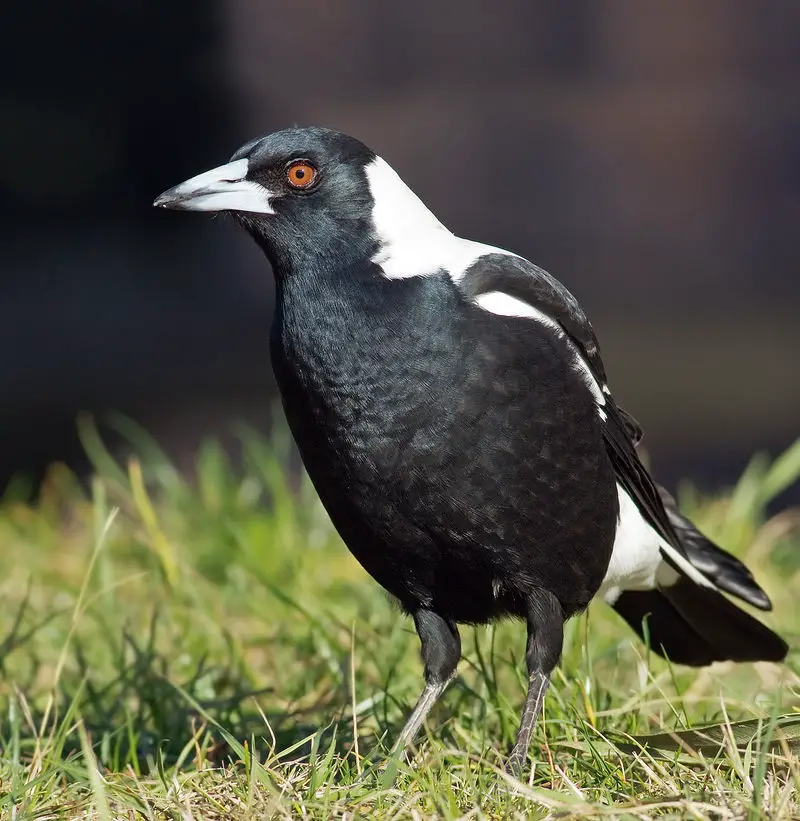
The Australian magpie is a beautiful passerine bird native to Australia and southern New Guinea.
It has distinctive black and white plumage, with males having more brightly coloured feathers than females.
The species is part of the Artamidae family, so it’s closely related to the Black Butcherbird (Melloria quoyi). Nine different subspecies have been recognised which vary slightly in size and colouring.
Magpies are omnivorous birds meaning they eat both plants and animals; their diet consists mainly of insects, small reptiles and amphibians as well as some grains such as wheat or oats.
They also enjoy drinking from pools of water on hot days. In general these birds display high intelligence when compared to other avian species – able to mimic human speech patterns quite accurately even in captivity.
Overall this majestic creature deserves our appreciation for its beauty, loyalty and fascinating behaviour.Scientific classification:
| Kingdom | Animalia |
| Phylum | Chordata |
| Class | Aves |
| Order | Passeriformes |
| Family | Artamidae |
| Genus | Gymnorhina Gray, GR, 1840 |
| Species | G. tibicen |
Also Featured In: Black And White Birds You Don’t Know About,
7. Laughing Kookaburra
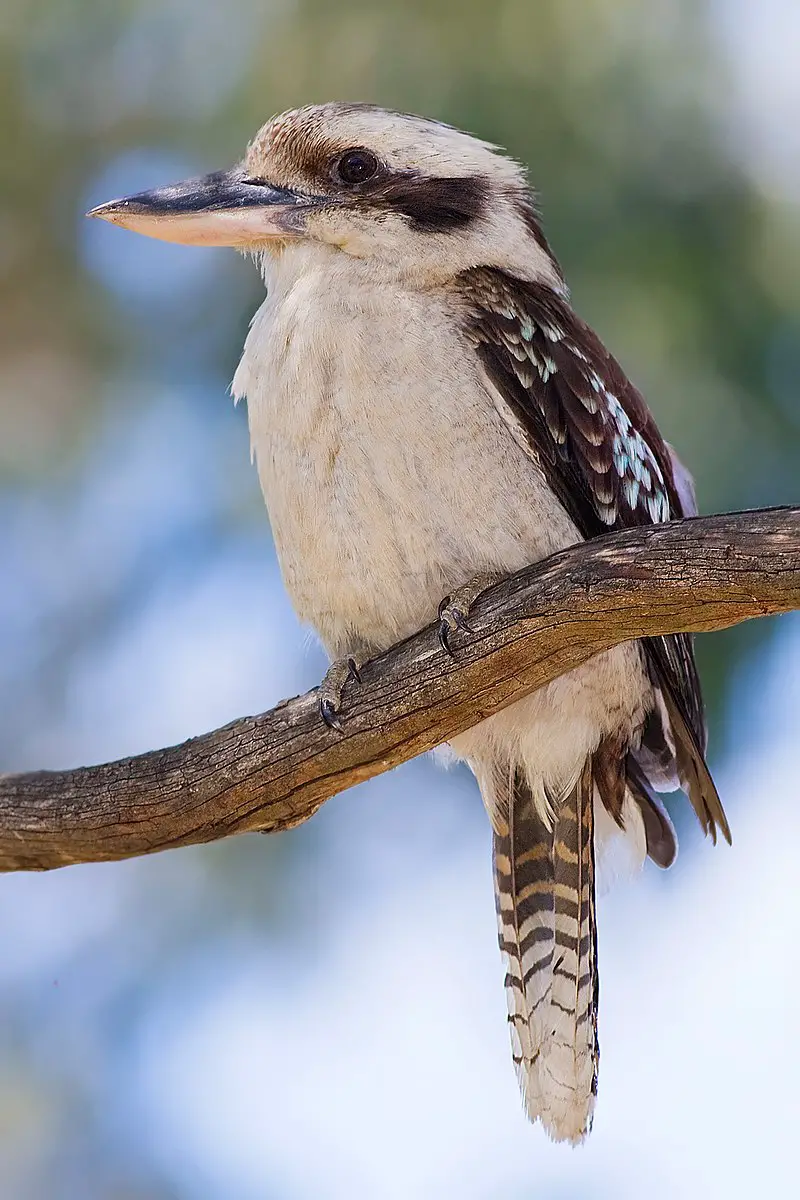
The Laughing Kookaburra is a beautiful bird with distinct features. It has a whitish head and brown eye-stripe, along with an upper body that is predominantly dark brown.
On its wings are mottled light blue patches which make it stand out even more. Its underparts are cream white while its tail is barred in rufous and black colours.
Male and female birds have the same plumage, making them easy to identify as belonging to this species of kingfisher subfamily Halcyoninae.
They can be found living around woodlands or open forests throughout eastern Australia, where they feed on small reptiles, insects or amphibians by swooping down from a perch above them before carrying their prey back up again for consumption.
The sound of their loud distinctive call – “koo-kaa-brrr” – brings joy to many Australians who appreciate these wonderful creatures inhabiting our landScientific classification:
| Kingdom | Animalia |
| Phylum | Chordata |
| Class | Aves |
| Order | Coraciiformes |
| Family | Alcedinidae |
| Subfamily | Halcyoninae |
| Genus | Dacelo |
| Species | D. novaeguineae |
Also Featured In: Birds You’ll Find in Zoo, Birds that Live in Sunshine Coast
8. Superb Fairywren
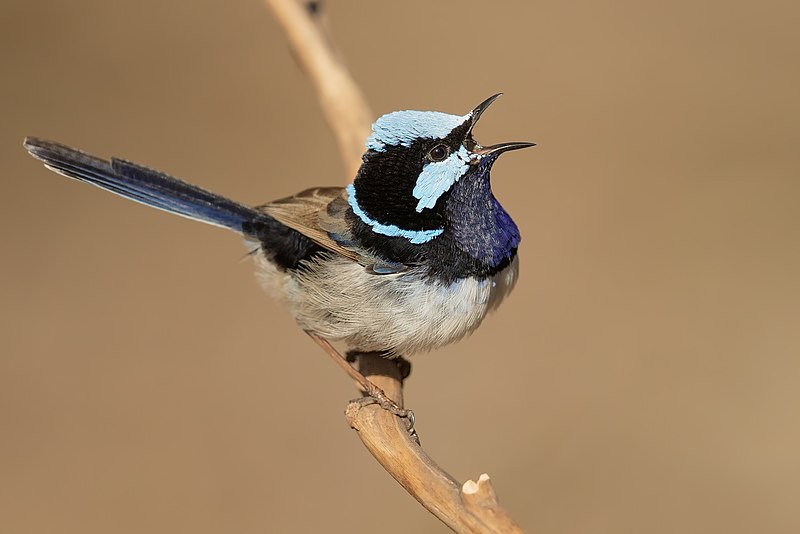
The Superb Fairywren is a beautiful and unique bird native to southeastern Australia.
The male in breeding plumage has an impressive bright blue forehead, ear coverts, mantle and tail with a black mask and either black or dark blue throat.
They are sedentary birds that form strong territorial bonds with their mates; the males staying close-by while the females build nests away from them.
These birds exhibit high sexual dimorphism; making it easy for us to distinguish between males and females of this species.
Their diet consists primarily of insects although they will also feed on other invertebrates as well as nectar, fruit and seeds when available.
This small passerine bird is sure to bring any garden alive with its vibrant colours.Scientific classification:
| Kingdom | Animalia |
| Phylum | Chordata |
| Class | Aves |
| Order | Passeriformes |
| Family | Maluridae |
| Genus | Malurus |
| Species | M. cyaneus |
9. Black Swan
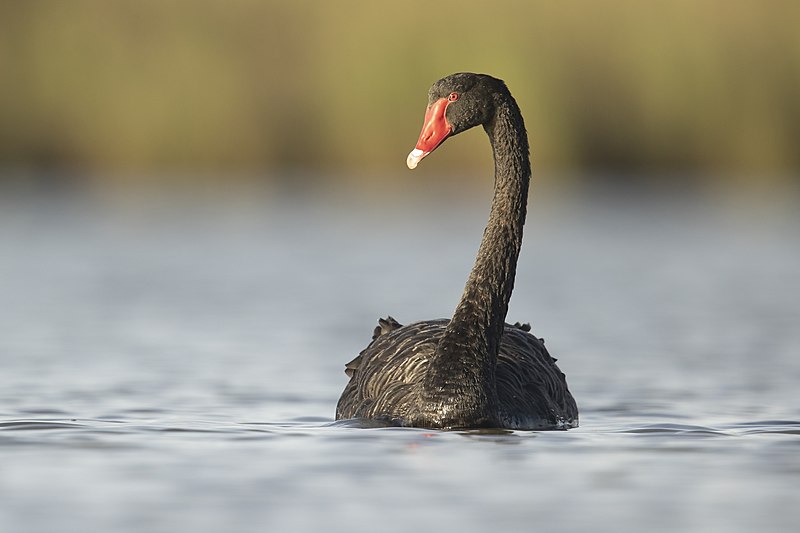
The Black Swan is a beautiful species of swan found in many parts of Australia. It has black plumage and a bright red bill, making it quite distinctive from other birds in the region.
These majestic birds are monogamous and both parents take turns incubating eggs as well as raising cygnets together.
They have an erratic migration pattern that depends on climatic conditions, although they usually move within their native range to find suitable habitats for breeding and feeding purposes.
The Black Swan’s graceful presence adds beauty to any water body they inhabit while also serving as important indicators of environmental health due to their sensitivity towards changes in their habitat quality.Scientific classification:
| Kingdom | Animalia |
| Phylum | Chordata |
| Class | Aves |
| Order | Anseriformes |
| Family | Anatidae |
| Genus | Cygnus |
| Species | C. atratus |
Also Featured In: Black Birds in New Zealand,
10. Wedge-Tailed Eagle
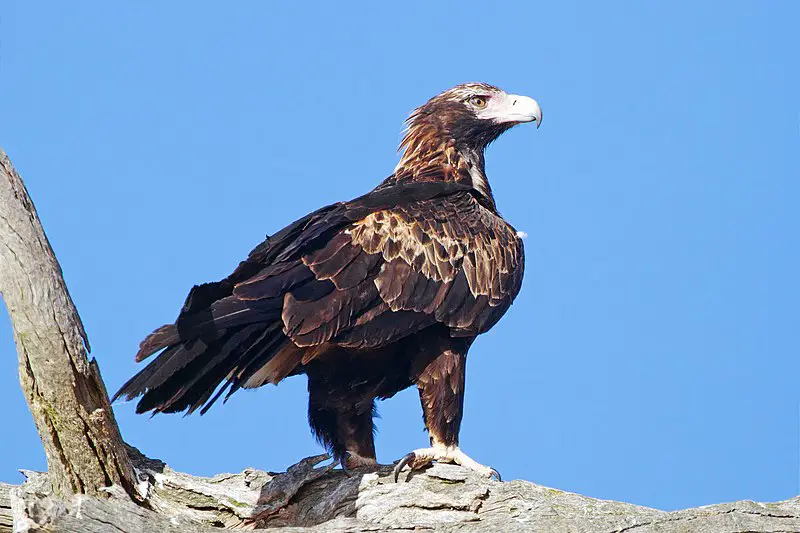
The majestic Wedge-tailed Eagle is a sight to behold in the skies above Australia, New Guinea and Tasmania.
With its long broad wings, fully feathered legs, distinctive wedge-shaped tail and powerful beak and feet it stands out from other birds of prey with ease.
This large raptor has an impressive wingspan ranging between 1.8m – 2.3m for males while females are slightly larger at up to 2.6m wide.
Its diet mainly consists of carrion but they have also been known to hunt for rabbits or small mammals such as rock wallabies when food is scarce due their sharp talons that can easily tear apart their prey’s flesh with one swift movement.
Despite being listed as near threatened these beautiful creatures still remain fairly common throughout its range making them a true delight to see soaring through our Aussie skies.Scientific classification:
| Kingdom | Animalia |
| Phylum | Chordata |
| Class | Aves |
| Order | Accipitriformes |
| Family | Accipitridae |
| Genus | Aquila |
| Species | A. audax |
11. Australian Pelican
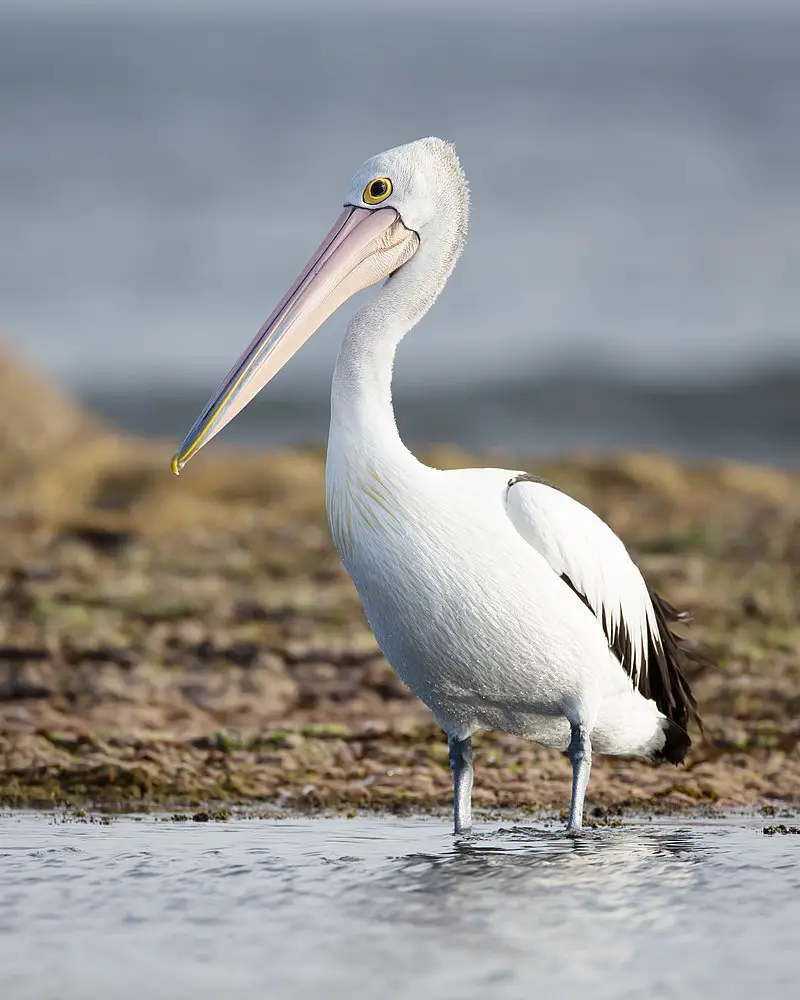
The Australian pelican is a majestic large waterbird with predominantly white plumage and black wings.
It has the longest bill of any living bird, which it uses to fish for its main source of food in both inland and coastal waters of Australia, New Guinea, Fiji, parts of Indonesia and as a vagrant in New Zealand.
They usually feed together by forming lines or circles around their prey before dipping down into the water at once.
In addition to fishing they also scavenge on other sources such as eggs from nesting seabirds or carrion.
Their unique appearance makes them an iconic species that can be easily recognised across many areas throughout Australasia making them popular amongst tourists who come to see them up close.Scientific classification:
| Kingdom | Animalia |
| Phylum | Chordata |
| Class | Aves |
| Order | Pelecaniformes |
| Family | Pelecanidae |
| Genus | Pelecanus |
| Species | P. conspicillatus |
Also Featured In: Birds that Live Near Adelaide,
12. Masked Lapwing
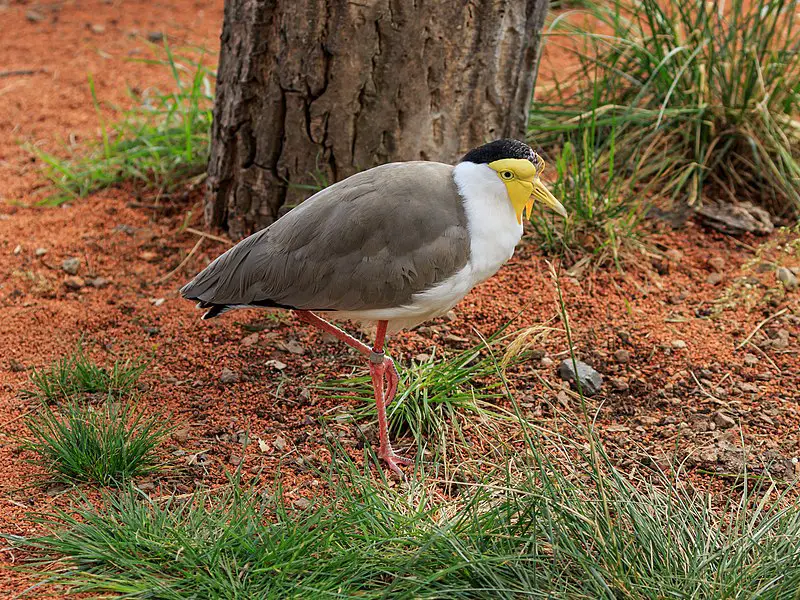
The Masked Lapwing is a large, distinctive bird that can be found in Australia, New Zealand and parts of Papua New Guinea.
It spends most of its time on the ground searching for food such as insects and worms, making it an important part of the local ecology.
It has several loud calls that are easily recognisable – from its ‘kwee-ep’ alarm call to its territorial ‘chi-wick’ call.
The Masked Lapwing is particularly known for swooping down when disturbed or threatened; however this behaviour serves to protect their nests with chicks during breeding season.
They inhabit open fields and grasslands which makes them easy to see if you’re lucky enough.Scientific classification:
| Kingdom | Animalia |
| Phylum | Chordata |
| Class | Aves |
| Order | Charadriiformes |
| Family | Charadriidae |
| Genus | Vanellus |
| Species | V. miles |
13. Silvereye
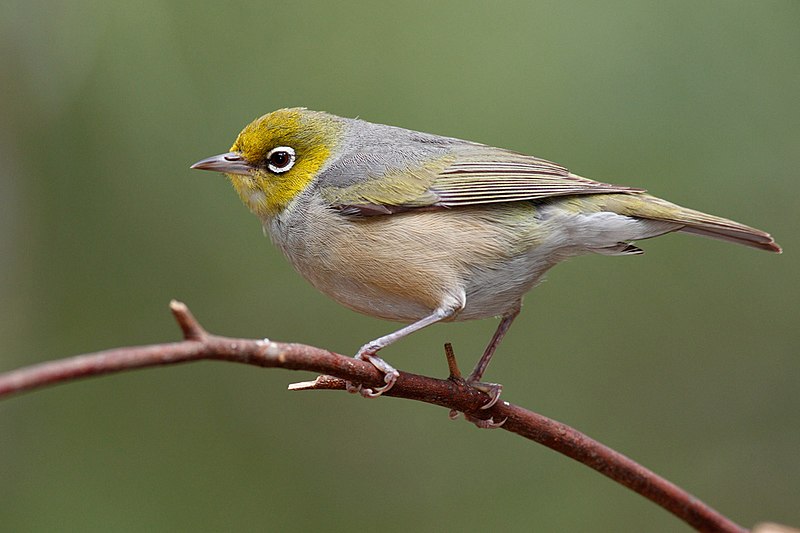
The silvereye, also known as wax-eye, is a tiny passerine bird native to the south-west Pacific region. It was first recorded in New Zealand in 1832 and there were greater numbers by 1856.
These birds are omnivorous feeders that make their home in open woodlands or gardens with lush vegetation.
Their plumage has greyish tones on top of its head and wings giving it a silver sheen look which inspired its common name ‘silvereye’.
The underside of these birds have white feathers allowing for camouflage among foliage when they fly low over shrubs and trees seeking food such as nectar, insects and fruit.
They are social creatures who often flock together to share meals while communicating through their unique chirps.Scientific classification:
| Kingdom | Animalia |
| Phylum | Chordata |
| Class | Aves |
| Order | Passeriformes |
| Family | Zosteropidae |
| Genus | Zosterops |
| Species | Z. lateralis |
Also Featured In: New Zealand Birds, Silver Birds You Should Know
14. Brown Goshawk
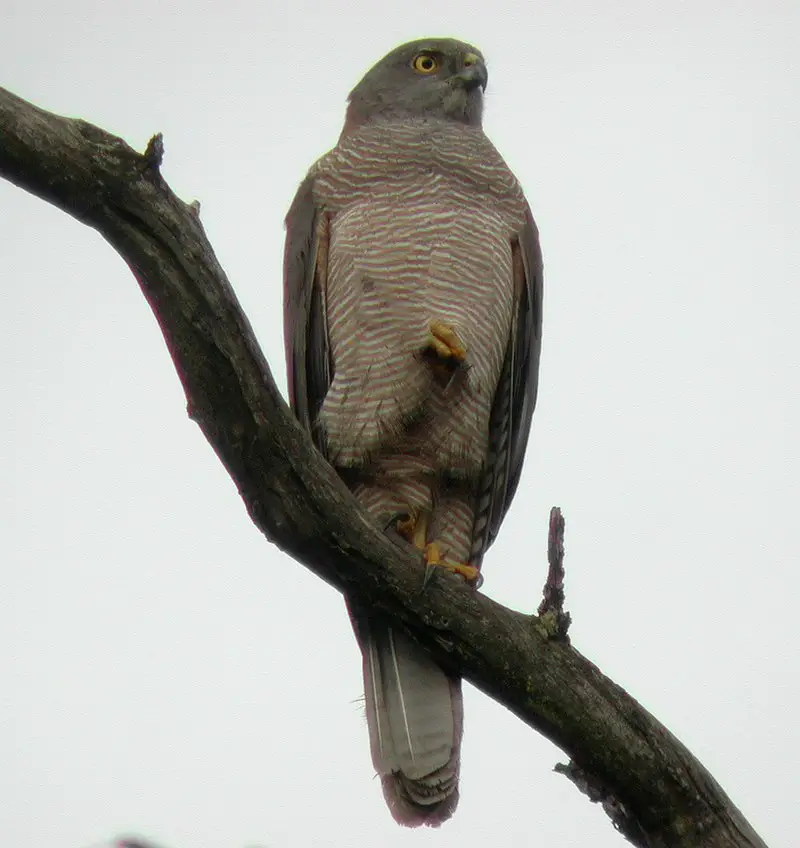
The Brown Goshawk is a medium-sized bird of prey that can be found in Australia and its surrounding islands.
It has grey upperparts with chestnut collar, while the underparts are mainly rufous finely barred with white.
This gives it similar colouring to collared sparrowhawk but it is larger as compared to them; body length being between 40-55 cm.
The flight of this majestic raptor is fast and flexible making for an impressive sight when spotted in the sky.
Its diet consists mostly of small birds, mammals such as rodents or bats, large insects like grasshoppers etc., thus playing an important role in maintaining balance within local ecosystems by controlling population numbers these species.Scientific classification:
| Kingdom | Animalia |
| Phylum | Chordata |
| Class | Aves |
| Order | Accipitriformes |
| Family | Accipitridae |
| Genus | Accipiter |
| Species | A. fasciatus |
Also Featured In: Vanuatu birds,
15. Nankeen Kestrel
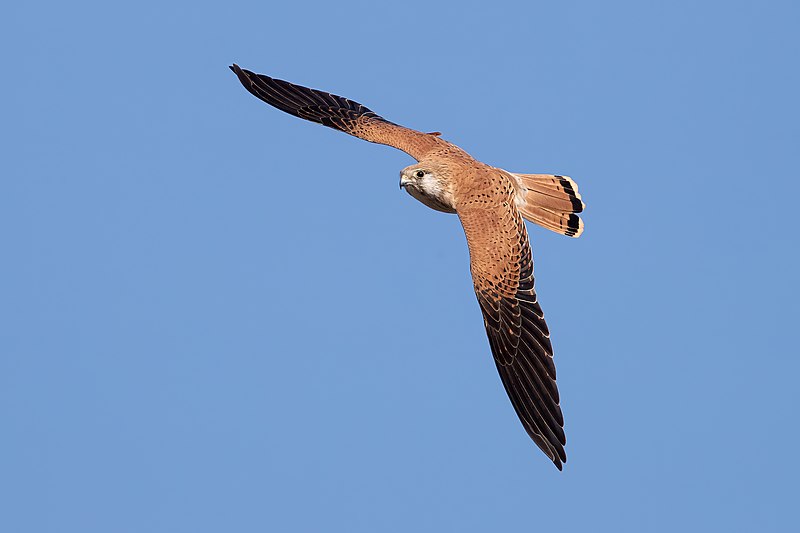
The nankeen kestrel is a small bird of prey native to Australia and New Guinea. Unlike many raptors, it does not rely on speed to capture its prey; instead, it perches in an exposed spot or hovers over fields and grasslands.
It belongs to the genus Falco which also includes other species such as peregrine falcons.
This bird typically has cinnamon-brown upperparts with dark wings and tail whilst its underside is usually pale buffish-white colouring with narrow black barring across the chest area.
Its diet consists mainly of insects but can include reptiles, amphibians, mice and even some birds among others depending on their availability within their habitat range.
The Nankeen Kestrel is an important part of our ecosystems providing essential services such as pest control for farmers by preying upon pests like locusts while also being a keystone species that influences surrounding habitats through predation or competition for resources amongst other animals.Scientific classification:
| Kingdom | Animalia |
| Phylum | Chordata |
| Class | Aves |
| Order | Falconiformes |
| Family | Falconidae |
| Genus | Falco |
| Species | F. cenchroides |
16. White-Faced Heron
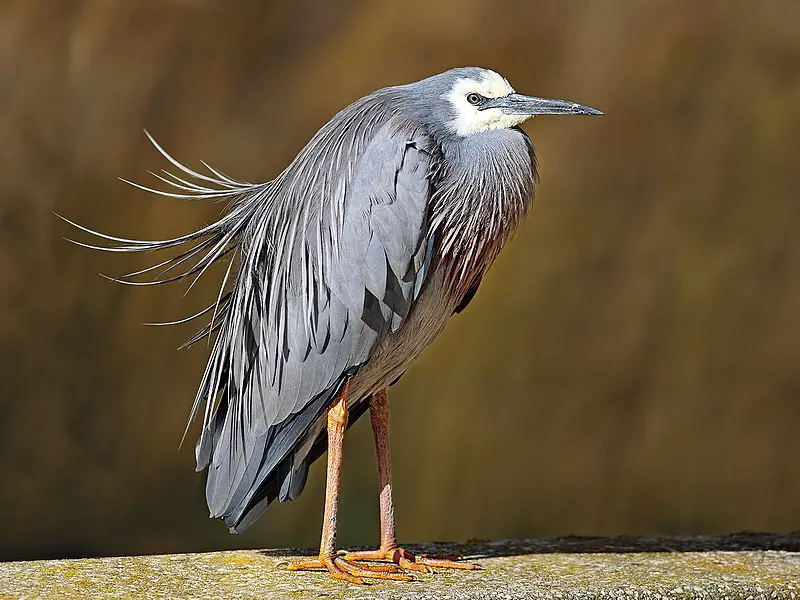
The White-faced Heron is a common sight throughout much of Australasia. With its pale, bluish grey feathers and yellow legs this bird stands out in the crowd.
It can be found on New Guinea, Torres Strait Islands and Indonesia as well as Australia and New Zealand but tends to avoid dry areas. This medium sized heron has one distinct feature – a white face.
Its diet consists mainly of small fish, lizards, frogs insects and crustaceans which it hunts for by wading into shallow water or searching through grasses near wetlands.
In flight they appear graceful with their long neck tucked back against their body giving them an elegant silhouette against the sky.
Their behaviour shows intelligence when finding food sources or evading predators making them interesting creatures to observe in nature.Scientific classification:
| Kingdom | Animalia |
| Phylum | Chordata |
| Class | Aves |
| Order | Pelecaniformes |
| Family | Ardeidae |
| Genus | Egretta |
| Species | E. novaehollandiae |
Also Featured In: Christmas Island Birds, Birds that Live around Brisbane
17. Brown Falcon
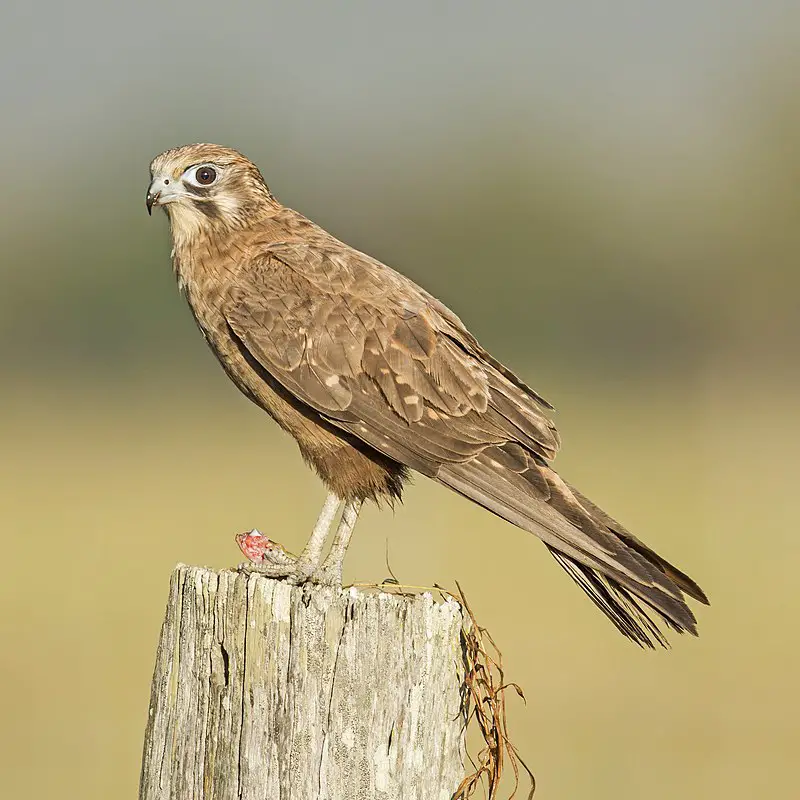
The Brown Falcon is a majestic bird native to Australia and New Guinea. It has a multitude of plumage morphs, with the primary difference being between pale and dark morph birds.
The light-colored ones typically have white undersides with some streaking, while their darker counterparts usually feature entirely brown upper parts.
These large falcons are highly adaptable predators that hunt small animals for food such as rabbits, snakes or lizards.
They also feed on carrion and grains during wintertime when prey becomes scarce. Thanks to its impressive flying abilities, it can quickly soar over vast distances in search of sustenance or mates by relying on powerful thermals ascending from the ground below them.Scientific classification:
| Kingdom | Animalia |
| Phylum | Chordata |
| Class | Aves |
| Order | Falconiformes |
| Family | Falconidae |
| Genus | Falco |
| Species | F. berigora |
Also Featured In: Falcons Species, Common Flinders Island Birds
18. Australian Hobby
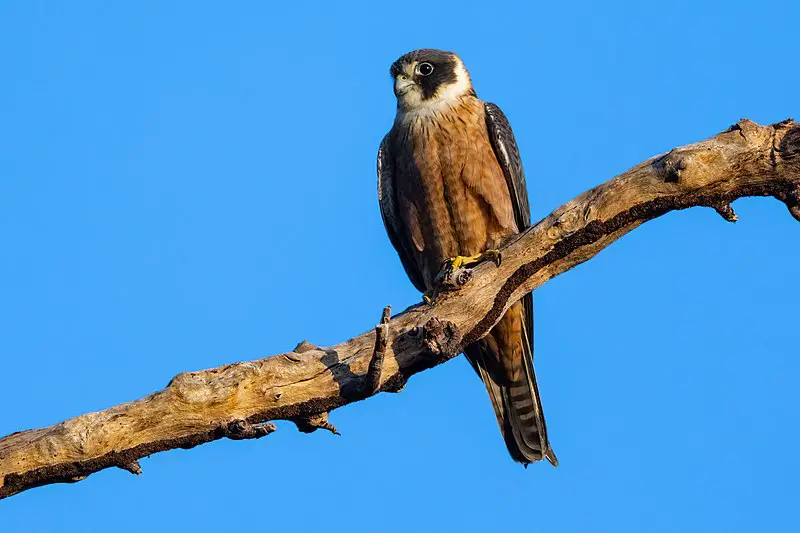
The Australian hobby is a small bird of prey found across Australia and its neighbouring countries. It has long primary wing feathers, which give it the scientific name Falco longipennis – meaning ‘long-winged’.
During migration season, members of this species can be seen on islands in Indonesia and New Guinea. The Australian hobby is mostly active during daylight hours but will sometimes hunt at night too.
Its diet consists mainly of insects such as dragonflies and grasshoppers, although some larger birds are also taken.
This adaptable predator inhabits both open areas like woodland clearings as well as densely populated urban environments where they take advantage of abundant food sources like city parks or gardens.Scientific classification:
| Kingdom | Animalia |
| Phylum | Chordata |
| Class | Aves |
| Order | Falconiformes |
| Family | Falconidae |
| Genus | Falco |
| Species | F. longipennis |
19. Azure Kingfisher
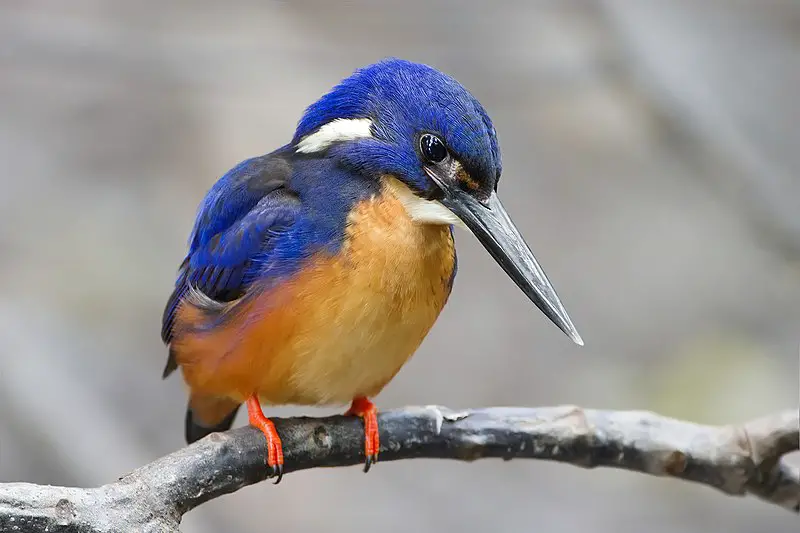
The Azure Kingfisher is a small and beautiful bird, easily recognized by its deep blue to azure back. It measures 17–19 cm in length with males weighing 29-32g and females 31-35g.
On the side of its neck there are large white to buff spots which further adds to the beauty of this species.
This kingfisher inhabits freshwater streams and rivers throughout Australia as well as New Guinea where it can be seen perching on branches next to water bodies or diving for food such as fish, frogs, aquatic insects, molluscs etc.
The Azure Kingfisher has an important role in maintaining healthy river ecosystems while also providing enjoyment when observed in their natural habitats.Scientific classification:
| Kingdom | Animalia |
| Phylum | Chordata |
| Class | Aves |
| Order | Coraciiformes |
| Family | Alcedinidae |
| Subfamily | Alcedininae |
| Genus | Ceyx |
| Species | C. azureus |
Also Featured In: Kingfishers Species, Birds that Charles Darwin Studied
20. Green Rosella
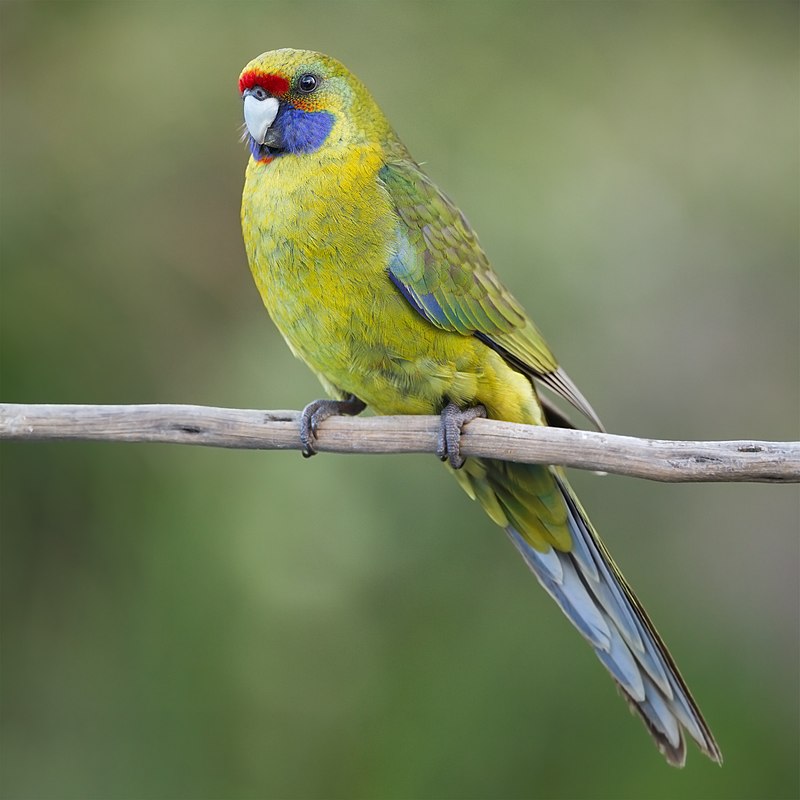
The Green Rosella is a beautiful parrot species that can be found in Tasmania and the Bass Strait islands.
It was first described by German naturalist Johann Friedrich Gmelin in 1788, although it got its name from mistakenly believing it came from New Caledonia.
At 14.5 inches (37 cm) long, this bird is the largest of the rosella genus Platycercus family. Two subspecies are recognised: P.c caledonicus which has bright red underparts and head; and P cecilae with lighter yellowish-orange plumage on its underside.
The upper parts of both male and female birds are green with blue cheeks, black scalloped markings along their wings and tails, while juveniles have brown heads instead of red or orange ones like adults do.
This stunning bird feeds mainly on seeds but also eats fruit, nectar blossoms as well as insects when available.
They typically nest high up in trees where they lay two to three eggs per clutch before incubating them for about 3 weeks until hatching occurs.Scientific classification:
| Kingdom | Animalia |
| Phylum | Chordata |
| Class | Aves |
| Order | Psittaciformes |
| Family | Psittaculidae |
| Genus | Platycercus |
| Species | P. caledonicus |
Also Featured In: Parrots Species,
21. Yellow-Tailed Black Cockatoo
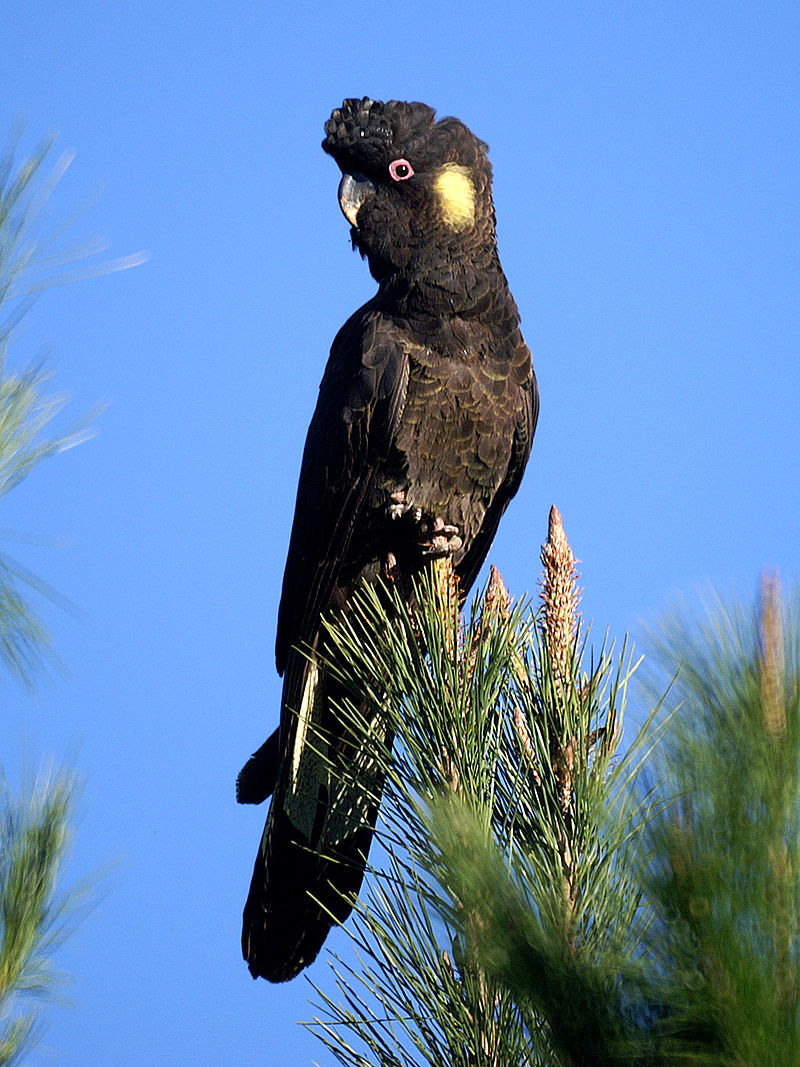
The Yellow-tailed Black Cockatoo is a beautiful bird native to Australia. It measures 55–65 cm in length and has an unmistakable look with its brownish black plumage, yellow cheek patches, short crest on the top of its head and prominent yellow tail band.
The feathers are also edged with yellow giving it a unique scalloped appearance. Males have a striking black beak while females have pink beaks with grey tips – making them easy to tell apart at first glance.
They prefer woodlands but can sometimes also be seen near urban areas as well as open grassy woodlands or forests where they feed on seeds from eucalypts, acacias and banksias among other plants.
They make loud screeching noises when flying which makes them easily identifiable even from afar.Scientific classification:
| Kingdom | Animalia |
| Phylum | Chordata |
| Class | Aves |
| Order | Psittaciformes |
| Family | Cacatuidae |
| Genus | Zanda |
| Species | Z. funerea |
Also Featured In: Birds that Live around Victoria, South Australian Birds
22. Orange-Bellied Parrot
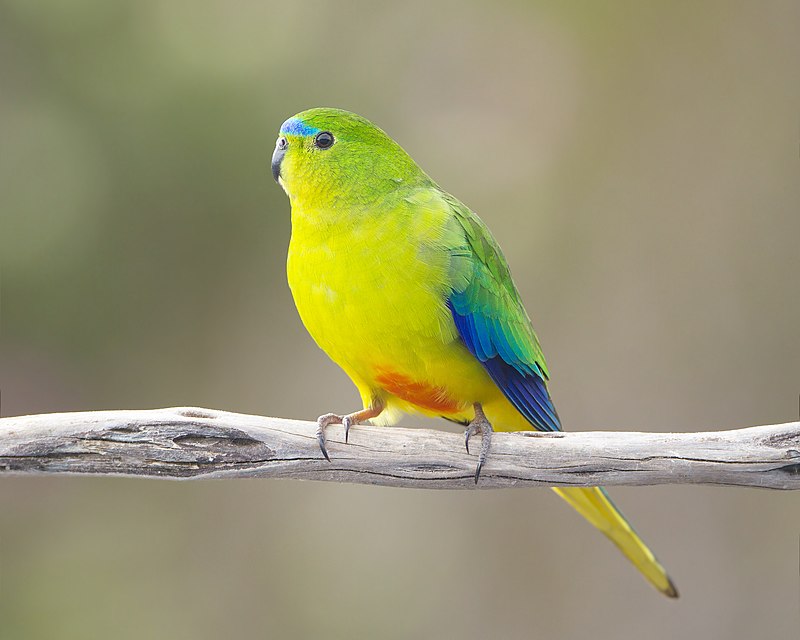
The orange-bellied parrot is a small bird native to Southern Australia, measuring only 8 inches long.
It’s distinguished by its bright grass-green upper parts and yellow underparts with an orange belly patch.
This species of parrot is one of just three that migrate seasonally, usually in flocks ranging from 5 to 50 birds.
During breeding season they inhabit coastal heathland and swamps but spend the rest of their time foraging wetlands further inland or sea coasts along Bass Strait islands.
Sadly this beautiful little bird has become endangered due to habitat loss and predation so conservation efforts are being made to protect it before it becomes extinct.Scientific classification:
| Kingdom | Animalia |
| Phylum | Chordata |
| Class | Aves |
| Order | Psittaciformes |
| Family | Psittaculidae |
| Genus | Neophema |
| Species | N. chrysogaster |
23. Black-Faced Cormorant
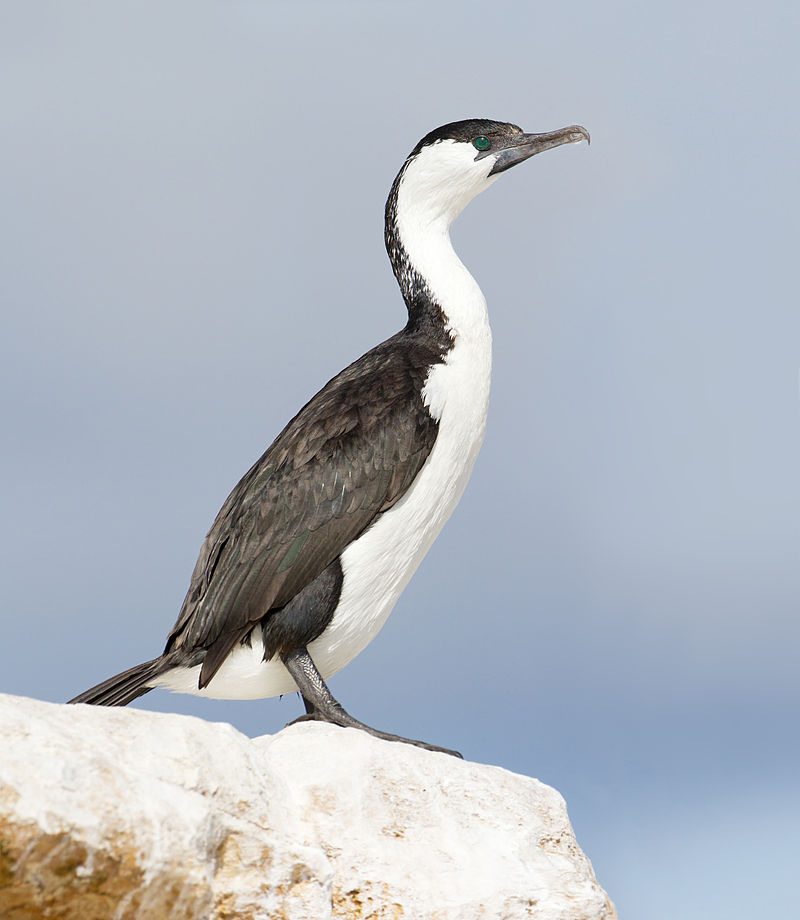
The Black-faced cormorant is a medium sized member of the cormorant family. It has an unmistakable black face, bill and upperparts which contrast wonderfully with its white underparts.
Endemic to coastal regions in southern Australia it can be seen aquatic bird roosting on rocky shores or perched atop trees near water bodies such as lakes, rivers and bays.
Its long hooked bill, webbed feet and powerful wings make it well adapted for diving underwater to hunt fish – their primary source of food.
With strong parental bonds they are often found nesting together in groups along cliffs or tree lined riverbanks helping each other raise their young ones until adulthood when they eventually leave the colony to fend for themselves.Scientific classification:
| Kingdom | Animalia |
| Phylum | Chordata |
| Class | Aves |
| Order | Suliformes |
| Family | Phalacrocoracidae |
| Genus | Phalacrocorax |
| Species | P. fuscescens |
Also Featured In: Cormorant Species, Birds that Live in Kangaroo Island
24. Welcome Swallow
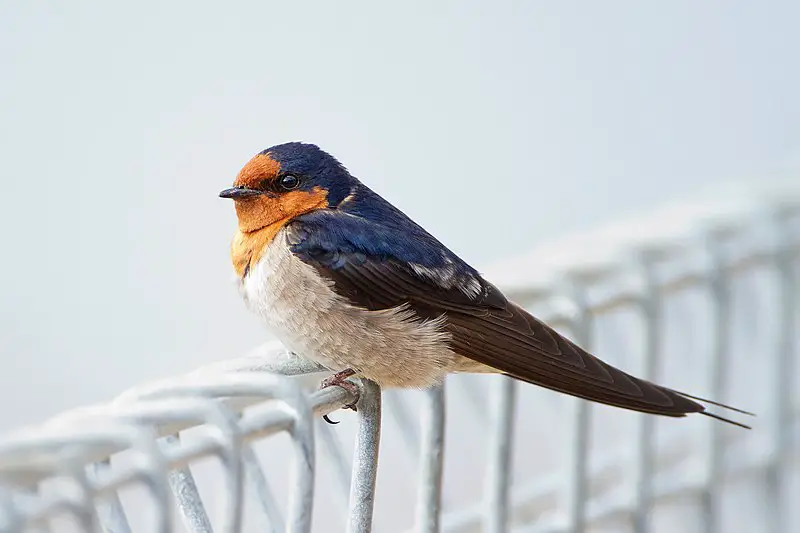
The Welcome Swallow (Hirundo neoxena) is a small passerine bird in the swallow family, native to Australia and nearby islands.
It was self-introduced into New Zealand in the mid twentieth century and is often considered conspecific with the Pacific swallow.
This species breeds mainly throughout southern and eastern Australia across various habitats such as woodlands, open countrysides, grasslands, marshes and coastal areas.
They are most commonly seen near human settlements like farmhouses or parks where they build their distinctive mud nests under eaves of buildings or on bridges.
The adults have steel-blue upperparts with pale rufous undersides while their throat has white stripes that extend down onto its breast feathers giving it a very attractive look.Scientific classification:
| Kingdom | Animalia |
| Phylum | Chordata |
| Class | Aves |
| Order | Passeriformes |
| Family | Hirundinidae |
| Genus | Hirundo |
| Species | H. neoxena |
Also Featured In: Swallows Species, Sydney Birds You Need to See
25. Grey Butcherbird
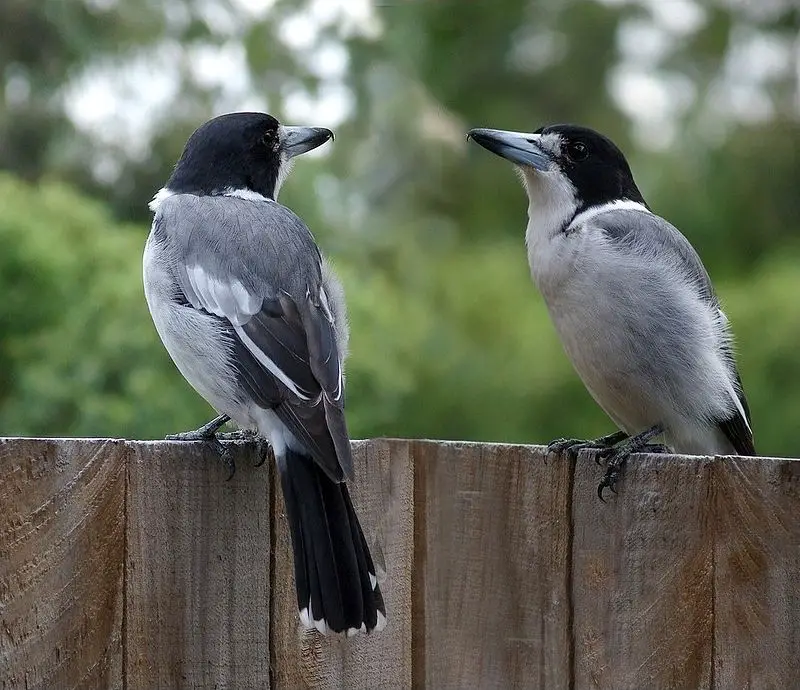
The Grey butcherbird is a species of bird found exclusively in Australia. It can be found in several different environments, including semi-arid and temperate zones.
The bird has a unique and distinctive birdsong. The Grey butcherbird is absent from the deserts of central Australia and the monsoon tropics of the north. It appears to be adaptable to its surroundings.Scientific classification:
| Kingdom | Animalia |
| Phylum | Chordata |
| Class | Aves |
| Order | Passeriformes |
| Family | Artamidae |
| Genus | Cracticus |
| Species | C. torquatus |
Also Featured In: Birds that You’ll find in Perth,
26. Australasian Grebe
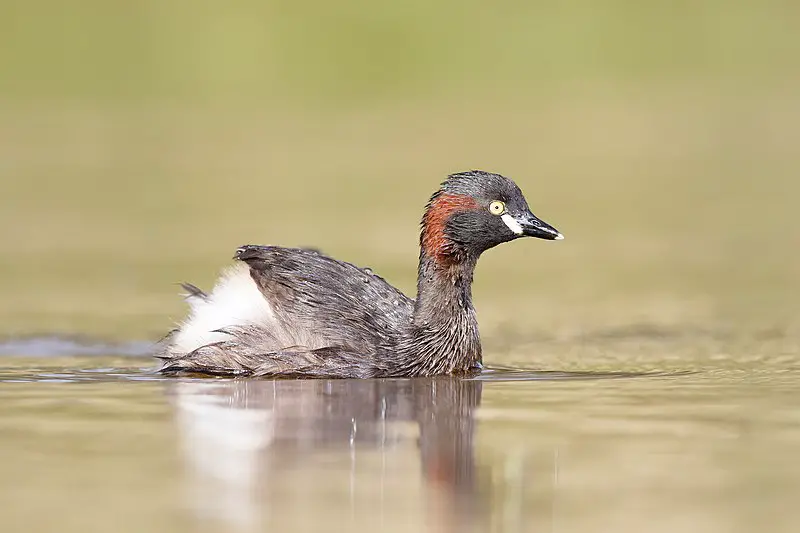
The Australasian grebe is a small waterbird that is frequently seen on fresh water lakes and rivers in Australia, New Zealand, and the Pacific islands. It is one of the smallest members of the grebe family, measuring only 25-27 cm in length.
The bird has a dark brown upper body and a glossy-black head and neck, making it quite striking in appearance.
Both male and female Australasian grebes look alike, and the species is known for its strong swimming and diving abilities.
Due to its reliance on freshwater ecosystems, the Australasian grebe is highly vulnerable to habitat loss and other environmental threats.
Conservation efforts are underway to protect this unique and important bird species.Scientific classification:
| Kingdom | Animalia |
| Phylum | Chordata |
| Class | Aves |
| Order | Podicipediformes |
| Family | Podicipedidae |
| Genus | Tachybaptus |
| Species | T. novaehollandiae |
Also Featured In: Queensland Birds You Should Know, Common Melbourne Birds
27. Black-Faced Cuckooshrike
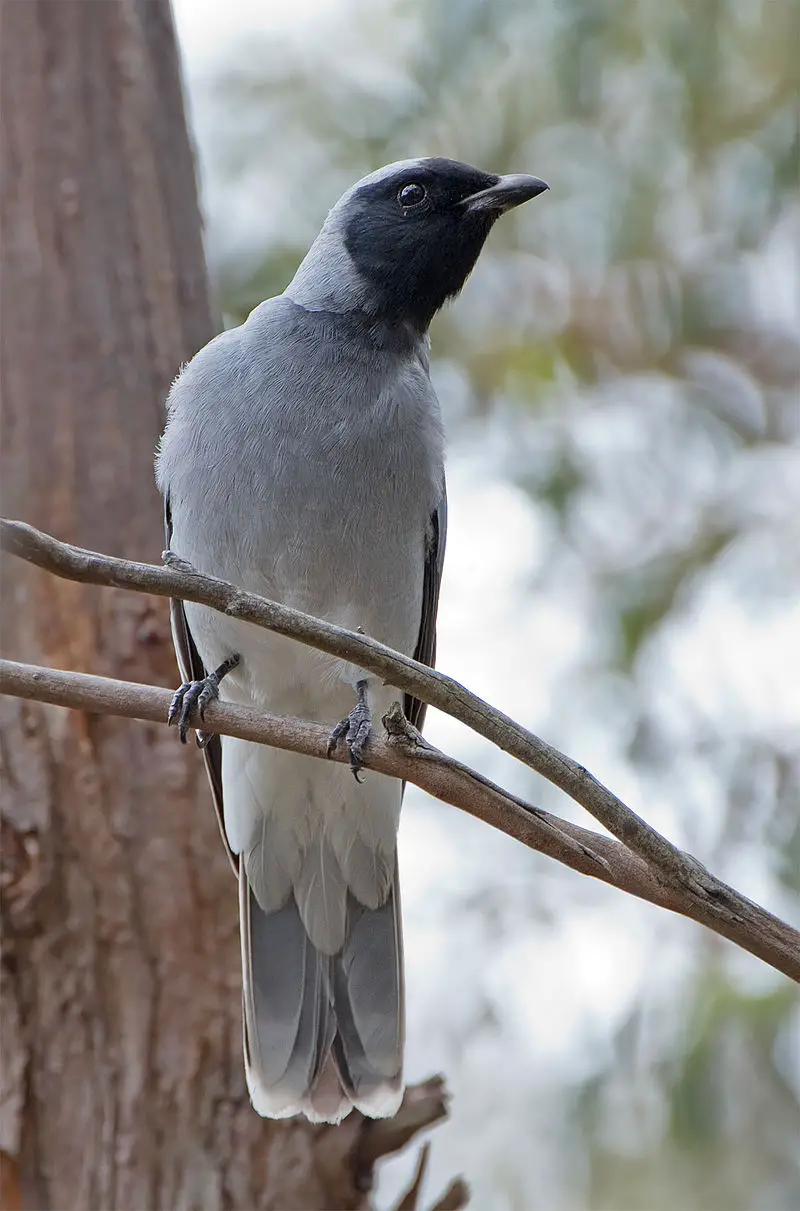
The Black-faced cuckooshrike, found in Australia and southern New Guinea, is a protected species under Australian law.
These birds are omnivorous and commonly seen in wooded habitats, with the exception of rainforests.
Despite this, they are also sometimes found in urban areas. The Black-faced cuckooshrike is a passerine bird and is known for its distinctive black facial markings.Scientific classification:
| Kingdom | Animalia |
| Phylum | Chordata |
| Class | Aves |
| Order | Passeriformes |
| Family | Campephagidae |
| Genus | Coracina |
| Species | C. novaehollandiae |
Also Featured In: Most Common Western Australia Birds, New South Wales Birds You Need to See
28. Spotted Pardalote
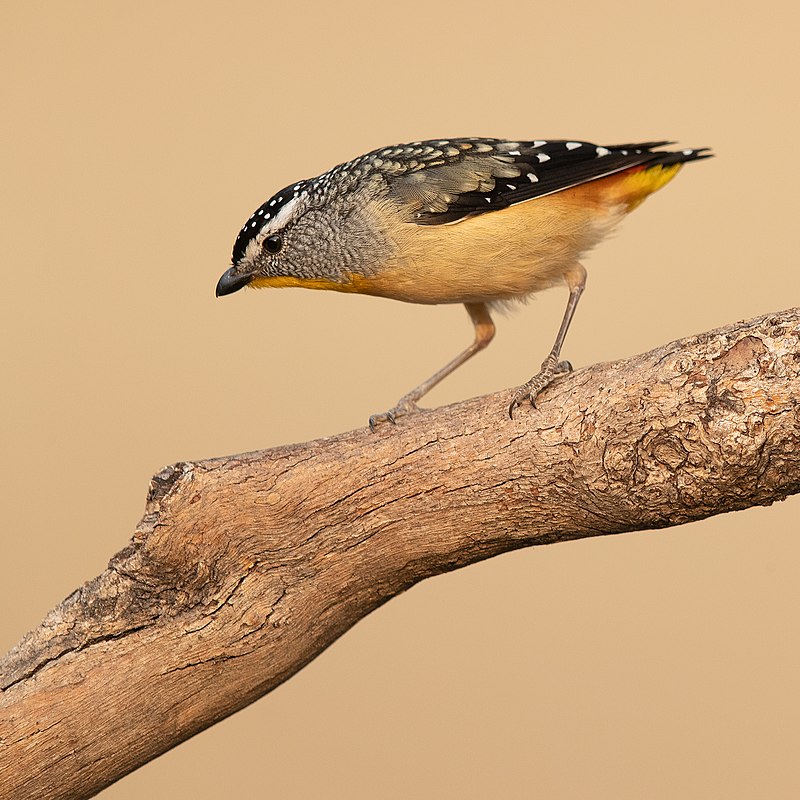
The spotted pardalote is a tiny bird found in various parts of Australia. It measures only 8 to 10 centimetres in length, making it one of the smallest birds in the country.
This colourful bird is also known as the diamondbird due to its bright plumage. Even though it is common in fertile regions of Australia, it is rarely seen up close, making it challenging to identify.
It can be found in the east coast, the south-east, and the south-west corner of the country.
Despite its small size, the spotted pardalote is a vocal bird with a distinctive call. Due to their small size, they are particularly susceptible to harsh weather and habitat destruction.
These birds play a vital role in various ecosystems through their feeding behaviour and are essential seed distributors.Scientific classification:
| Kingdom | Animalia |
| Phylum | Chordata |
| Class | Aves |
| Order | Passeriformes |
| Family | Pardalotidae |
| Genus | Pardalotus |
| Species | P. punctatus |
29. Short-Tailed Shearwater
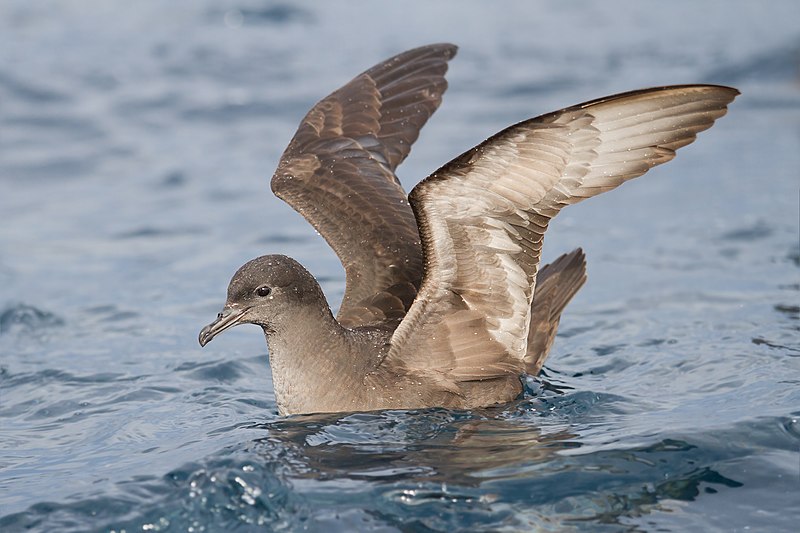
The Short-tailed Shearwater, also known as the Slender-billed Shearwater or Muttonbird, is a migratory seabird species that is native to Australia. It is the most common seabird in Australian waters and is commercially harvested for its chicks.
The bird mainly breeds on small offshore islands and feeds on fish, squid, and zooplankton. Its distinctive call can be heard from far away as it flies low over the ocean.
The Short-tailed Shearwater is an important species for both the ecosystem and the economy, providing food for predators such as foxes and eagles, and supporting a small-scale commercial fishery.
The species faces threats from climate change, pollution, and overfishing, highlighting the need for conservation efforts to protect this important bird.Scientific classification:
| Kingdom | Animalia |
| Phylum | Chordata |
| Class | Aves |
| Order | Procellariiformes |
| Family | Procellariidae |
| Genus | Ardenna |
| Species | A. tenuirostris |
Also Featured In: Birds that Live in the Ocean , Birds that Live near Bering Island
30. Eastern Spinebill
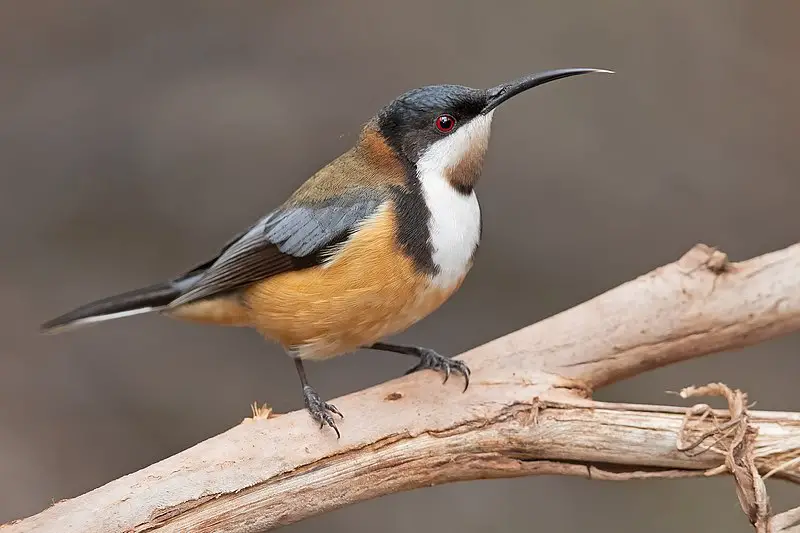
The Eastern spinebill, a honeyeater species, can be found in south-eastern Australia in various habitats, including forest, woodland, and urban gardens in Canberra, Sydney, Melbourne, and Adelaide.
It is distinguishable by its unique black, white, and chestnut feathers, a red eye, and a long bill that curves downwards.
It measures approximately 15 cm in length. The bird was originally identified as Certhia tenuirostris by an English ornithologist.
This bird species is famous for its love of nectar and the way it hovers in front of flowers to feed, leading to cross-pollination.
The Eastern spinebill is popular among birdwatchers due to its eye-catching plumage and its presence in urban areas. The species has an affinity for garden beds that have desirable nectar plants.
This bird is known for its swift and agile flying, which enables it to dart away from predators quickly.Scientific classification:
| Kingdom | Animalia |
| Phylum | Chordata |
| Class | Aves |
| Order | Passeriformes |
| Family | Meliphagidae |
| Genus | Acanthorhynchus |
| Species | A. tenuirostris |
Also Featured In: Birds that Live in Gold Coasts, Small Birds that Live in New South Wales
31. Little Penguin
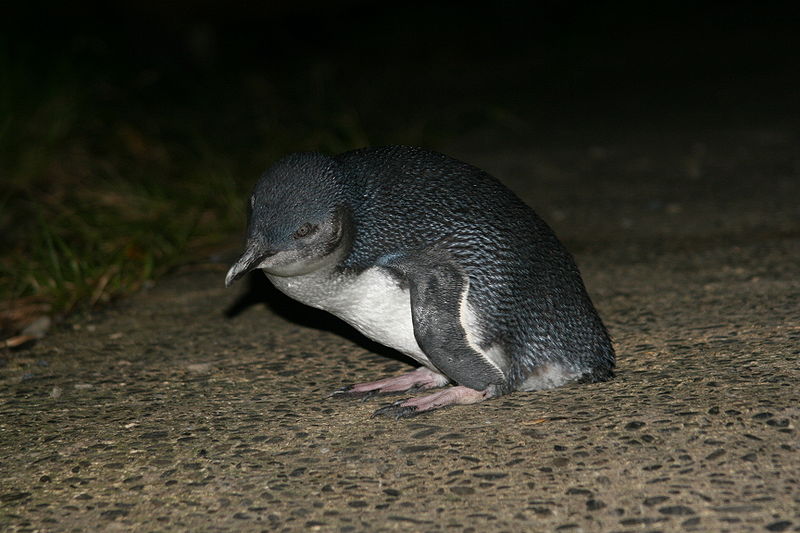
The Little Penguin, also known as the Blue Penguin or Kororā in Māori, is a type of penguin found in New Zealand. With its distinctive slate-blue plumage, it is a beloved symbol of the island nation’s wildlife.
The Little Penguin is a small bird that stands no taller than 40cm and weighs a mere 1kg, making it the smallest species of penguin in the world.
It can be found in many coastal and offshore areas around New Zealand, and is also known to frequent parts of Australia.
In fact, there is such a strong connection between New Zealand and this dapper little bird that it is often used as the mascot for local sports teams and other cultural events.
Despite its diminutive size, the Little Penguin is a tough survivor that has adapted well to the challenges of life in the wild.Scientific classification:
| Kingdom | Animalia |
| Phylum | Chordata |
| Class | Aves |
| Order | Sphenisciformes |
| Family | Spheniscidae |
| Genus | Eudyptula |
| Species | E. minor |
Also Featured In: Birds You’ll Find in Night, Most Common Birds in Oceania
32. Brown Thornbill
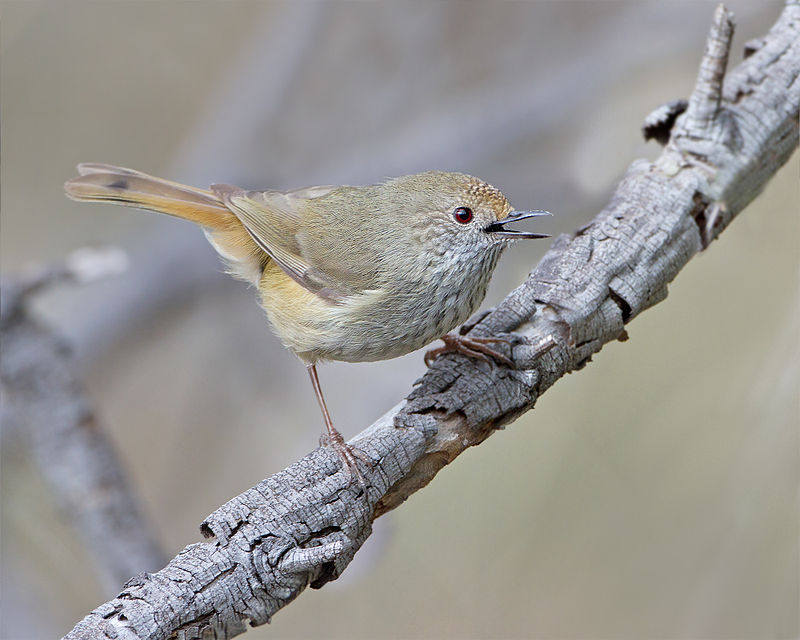
The Brown thornbill is a small bird native to eastern and south-eastern Australia, including Tasmania. With a maximum length of 10 cm, the bird is predominantly brown, gray, and white in appearance.
It belongs to the order Passeriformes and the family Acanthizidae, with the species consisting of five different subspecies. The bird’s diet mainly includes insects.
Its habitat includes various forest types, woodlands, and heaths, where it prefers to inhabit the lower layers of vegetation.
The Brown thornbill is known to be a skillful forager, and it generally feeds on insects found on the bark and leaves of trees.
The bird’s beautiful plumage and melodious chirping make it a popular species amongst birdwatchers and nature enthusiasts.Scientific classification:
| Kingdom | Animalia |
| Phylum | Chordata |
| Class | Aves |
| Order | Passeriformes |
| Family | Acanthizidae |
| Genus | Acanthiza |
| Species | A. pusilla |
Also Featured In: Birds of King Island,
33. Musk Duck
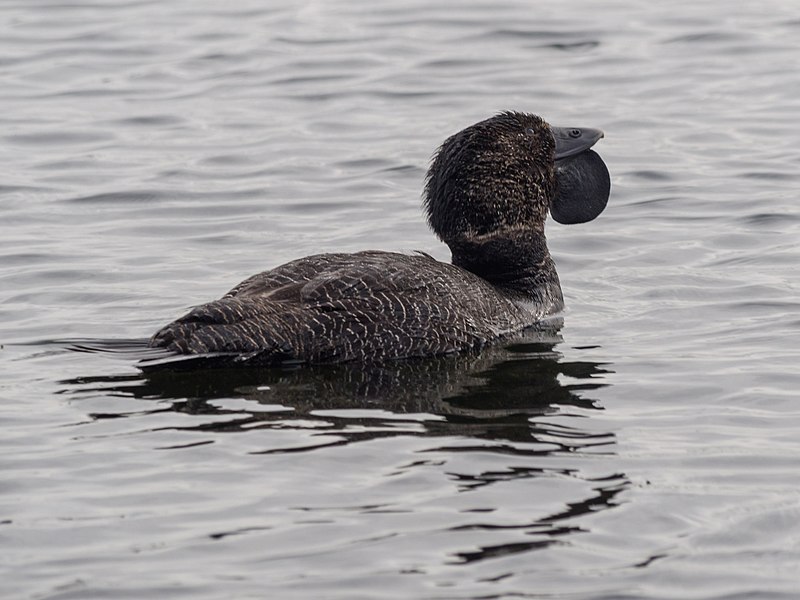
The musk duck is a unique water bird found in southern Australia. It is the only surviving member of the Biziura genus. An extinct relative was once present in New Zealand.
The New Zealand musk duck was larger than the surviving species, with a particularly large head. The musk duck is highly aquatic and has a distinctive stiff tail.Scientific classification:
| Kingdom | Animalia |
| Phylum | Chordata |
| Class | Aves |
| Order | Anseriformes |
| Family | Anatidae |
| Genus | Biziura |
| Species | B. lobata |
34. Yellow Wattlebird
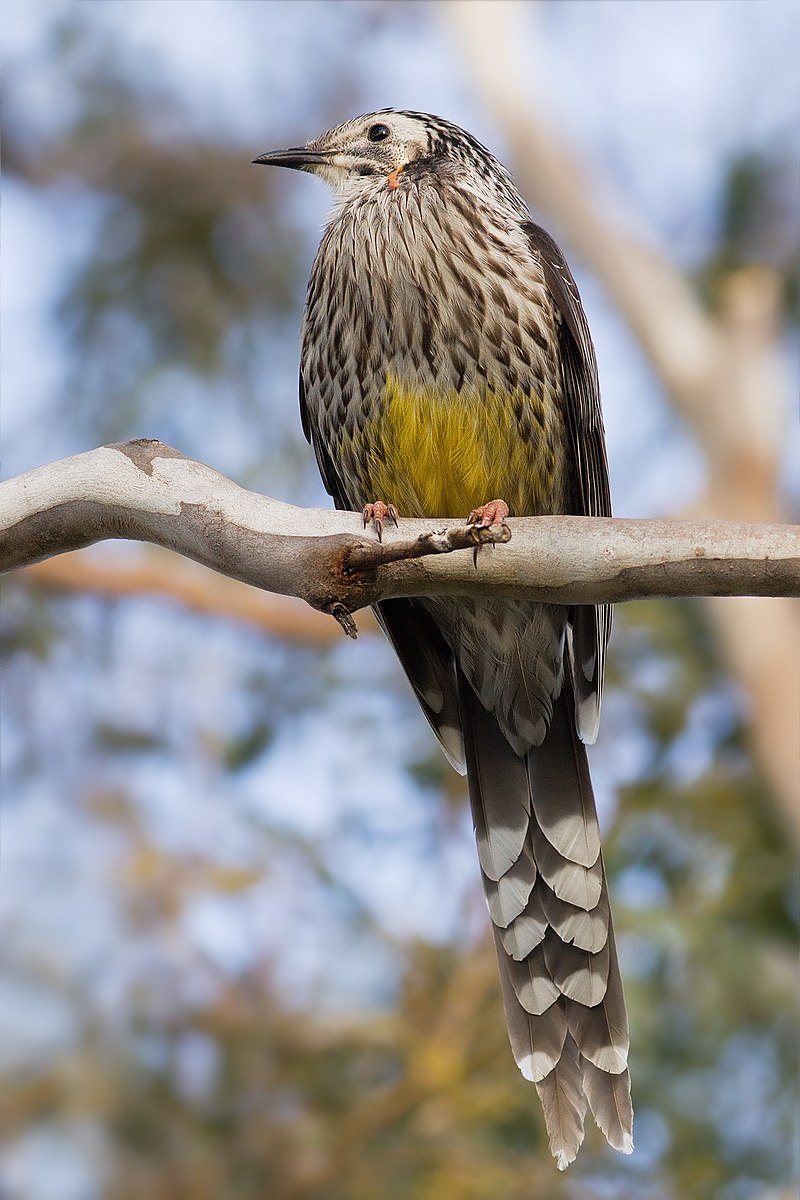
The Yellow Wattlebird is a species of bird belonging to the Meliphagidae family. It is also known as the Long Wattlebird or Tasmanian Wattlebird. This bird was first described in 1800 by the French zoologist François Marie Daudin.
Its scientific name, Anthochaera paradoxa, comes from the Ancient Greek words anthos meaning ‘flower’ and khairō meaning ‘enjoy’.
The Yellow Wattlebird is characterized by its long, wattle-like appendages on its neck which are brightly colored.
These birds are found in various habitats such as eucalypt forests, coastal heathlands, and even suburban parks. They feed on nectar, insects, and fruit.
Due to habitat loss and fragmentation, the Yellow Wattlebird is currently listed as a species of least concern on the IUCN Red List.Scientific classification:
| Kingdom | Animalia |
| Phylum | Chordata |
| Class | Aves |
| Order | Passeriformes |
| Family | Meliphagidae |
| Genus | Anthochaera |
| Species | A. paradoxa |
35. Forty-Spotted Pardalote
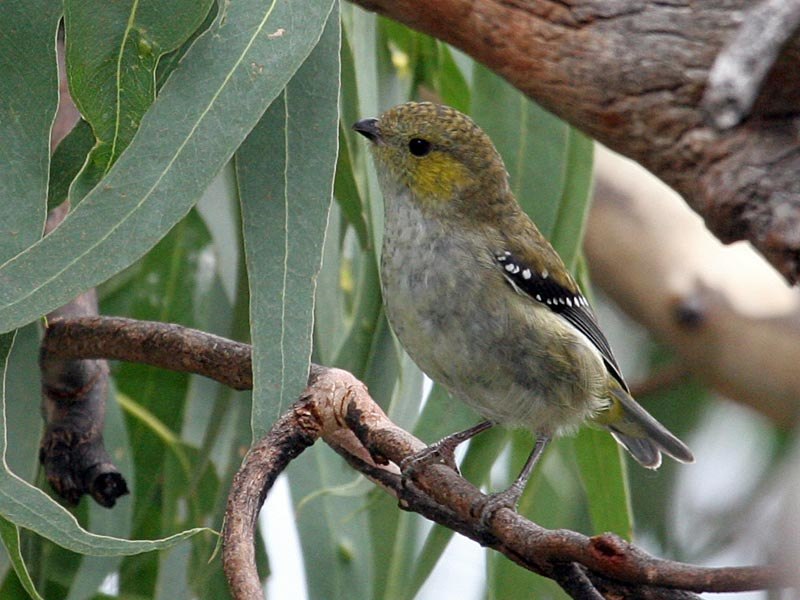
The forty-spotted pardalote is a rare and unique bird found only in a few colonies in Tasmania, Australia. It is the rarest pardalote species and is smaller in size, about 9 to 10 cm long.
This small and energetic passerine has distinctive features including forty distinct spots on its wings. The bird’s habitat is mainly on Maria Island and Bruny Island.
Although it resembles the more common spotted pardalote, the forty-spot pardalote has its unique features that distinguish it from the others.
The bird’s rarity is a result of habitat destruction and disturbance, causing a decline in their population.
Conservation efforts are in place to protect their habitat and aid their recovery to increase their numbers.
The forty-spotted pardalote is a fascinating species and a significant part of Tasmania’s biodiversity, making it a matter of conservation concern.Scientific classification:
| Kingdom | Animalia |
| Phylum | Chordata |
| Class | Aves |
| Order | Passeriformes |
| Family | Pardalotidae |
| Genus | Pardalotus |
| Species | P. quadragintus |
36. Black Currawong
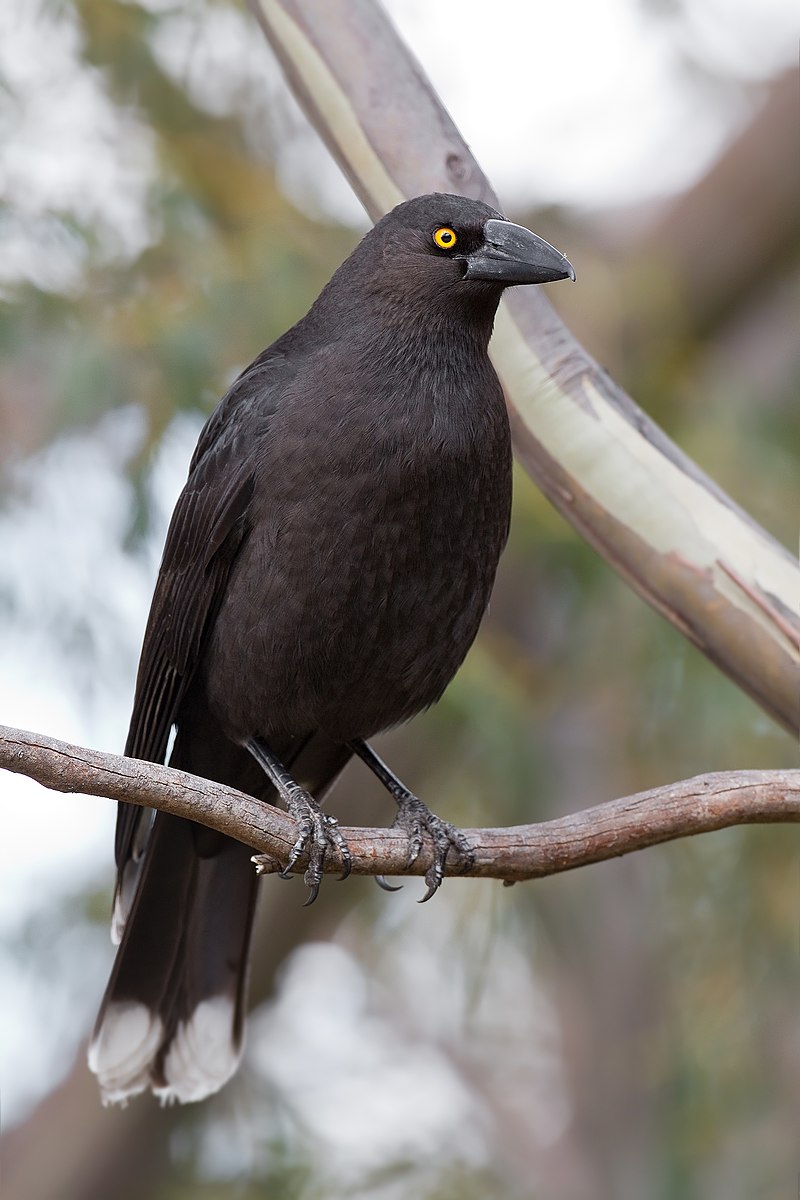
The black currawong, or black jay, is a bird found only in Tasmania and nearby islands. It is part of the Strepera genus, closely related to butcherbirds and magpies.
This large bird is about 50 cm long and has a black feather coat with yellow eyes. Despite its crow-like appearance, the black currawong has a unique and melodious call.
It is often found in forest and woodland areas but also ventures near human habitation for food. The black currawong is an important part of Tasmania’s ecosystem, helping to disperse seeds and control pest populations.
However, habitat destruction and introduced predators have threatened its population in recent years. Conservation efforts are underway to protect this unique and vital species.Scientific classification:
| Kingdom | Animalia |
| Phylum | Chordata |
| Class | Aves |
| Order | Passeriformes |
| Family | Artamidae |
| Genus | Strepera |
| Species | S. fuliginosa |
37. Yellow-Throated Honeyeater
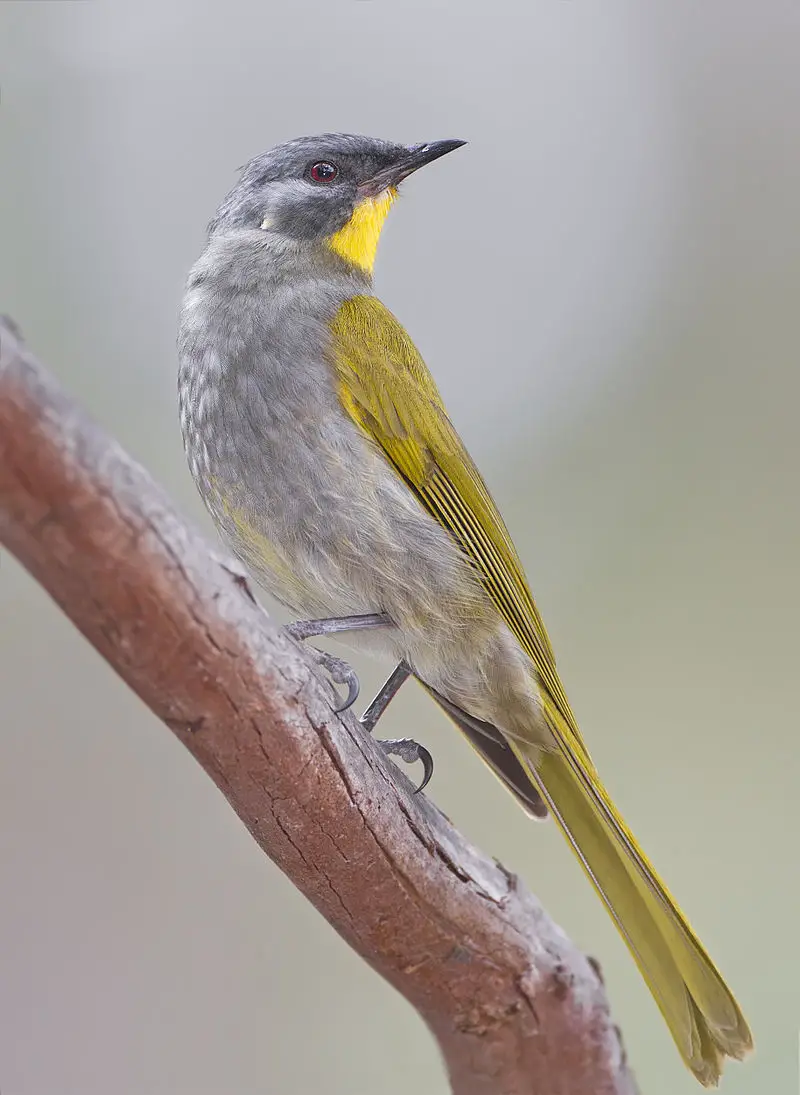
The Yellow-throated honeyeater is a species of passerine bird found exclusively in Tasmania, Australia. This bird has a similar appearance and behaviour to the white-eared honeyeater.
It was once regarded as harmful to orchards, but is now appreciated for its unique contribution to the ecosystem. It was first identified by Louis Jean Pierre Vieillot in the 18th century.
Overall, these small birds are charming and distinctive members of the Meliphagidae family.Scientific classification:
| Kingdom | Animalia |
| Phylum | Chordata |
| Class | Aves |
| Order | Passeriformes |
| Family | Meliphagidae |
| Genus | Nesoptilotis |
| Species | N. flavicollis |
38. Forest Raven
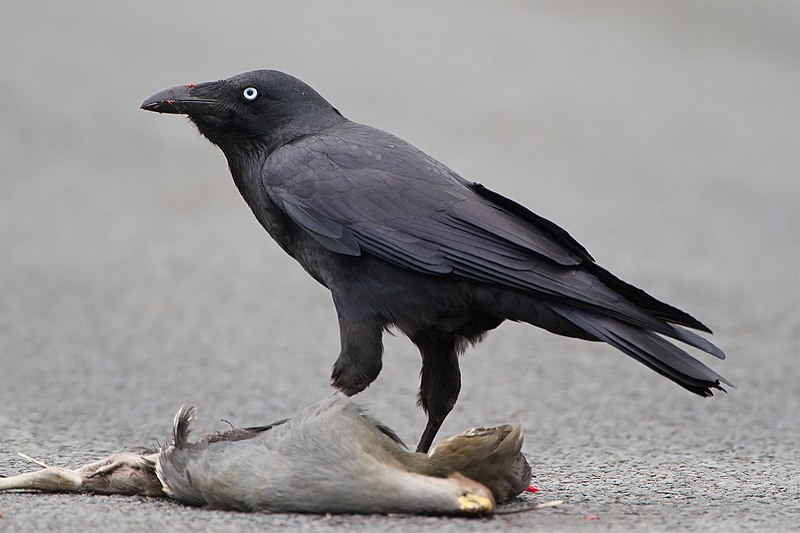
The forest raven, also known as the Tasmanian raven, is a black bird found in Tasmania, southern Victoria, and parts of New South Wales. It is a passerine bird in the Corvidae family with a length of 50-53 cm.
The forest raven has a dark beak and legs to complement its all-black plumage.Scientific classification:
| Kingdom | Animalia |
| Phylum | Chordata |
| Class | Aves |
| Order | Passeriformes |
| Family | Corvidae |
| Genus | Corvus |
| Species | C. tasmanicus |
39. Tasmanian Nativehen
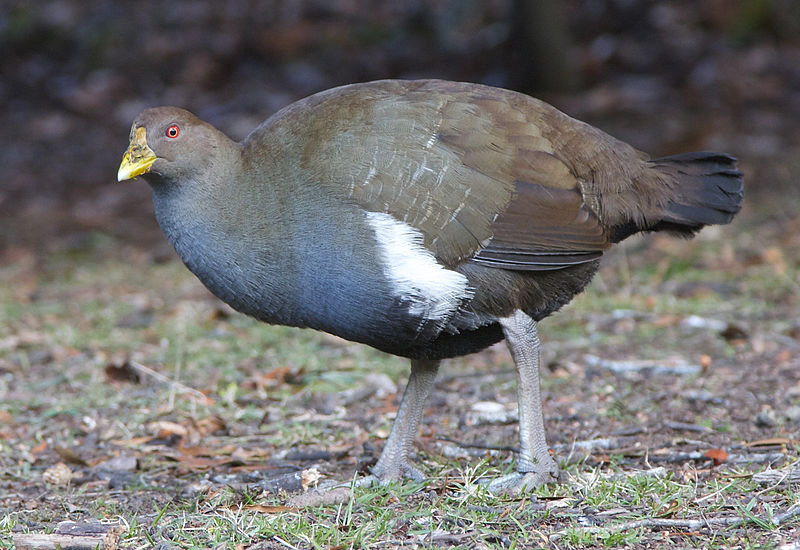
The Tasmanian nativehen, also known as piyura in the palawa kani language, is a flightless rail endemic to Tasmania. This bird species is one of twelve birds found only on the Australian island.
Despite the trend of extinction among many flightless birds due to human activity, the Tasmanian nativehen has actually benefited from the introduction of European-style farming. As a result, they are a relatively common sight in some parts of Tasmania today.
The bird is recognized for its distinguishing features such as its long legs and beak, as well as its olive-brown plumage and white tail feathers.
This species can often be found in wetlands and other marshy areas, where they feed primarily on seeds, small insects, and other invertebrates.Scientific classification:
| Kingdom | Animalia |
| Phylum | Chordata |
| Class | Aves |
| Order | Gruiformes |
| Family | Rallidae |
| Genus | Tribonyx |
| Species | T. mortierii |
40. Dusky Robin
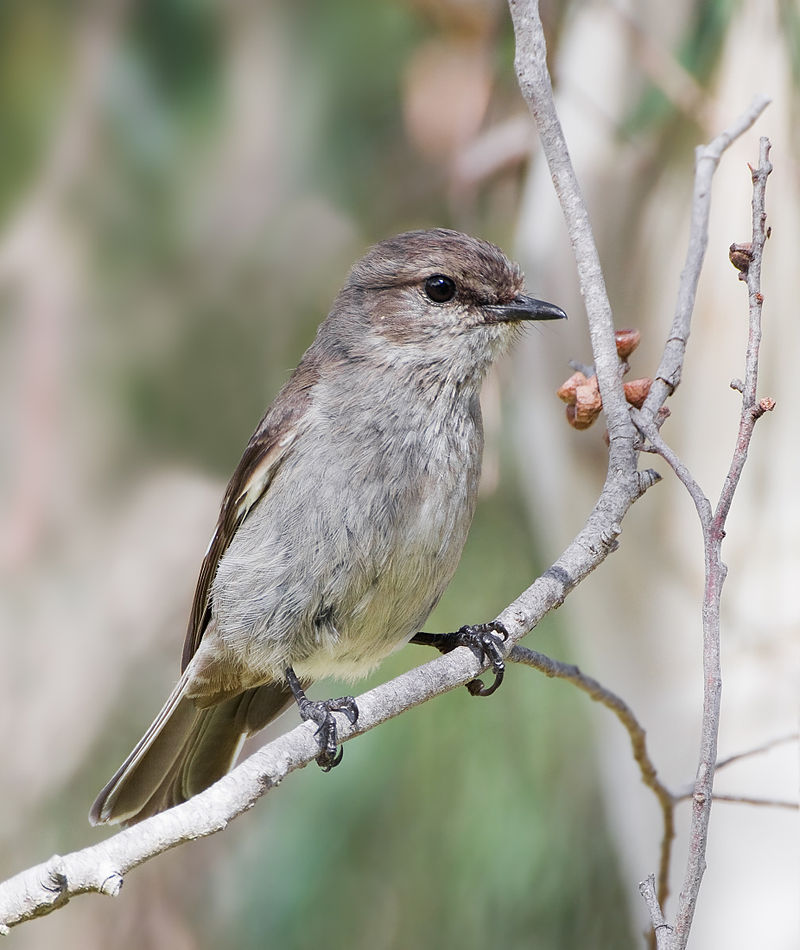
The dusky robin, a member of the Australian robin family Petroicidae, is a small passerine bird endemic to Tasmania. This bird is also known by several other names, including Dozey, Sleepy, and Stump.
It has a sombre dark brown appearance, with a narrow line behind the eye leading to the rear of the ear-coverts. White bars are present on its wings. Although it has a sad and melancholic appearance, it is a joy to hear its chirping melodies.
This native sparrow can often be spotted flitting between trees and shrubs, searching for insects to feed on.
Despite its small size, the dusky robin plays a significant role in the Tasmanian ecosystem, helping to keep insect populations under control.Scientific classification:
| Kingdom | Animalia |
| Phylum | Chordata |
| Class | Aves |
| Order | Passeriformes |
| Family | Petroicidae |
| Genus | Melanodryas |
| Species | M. vittata |
41. Pardalote
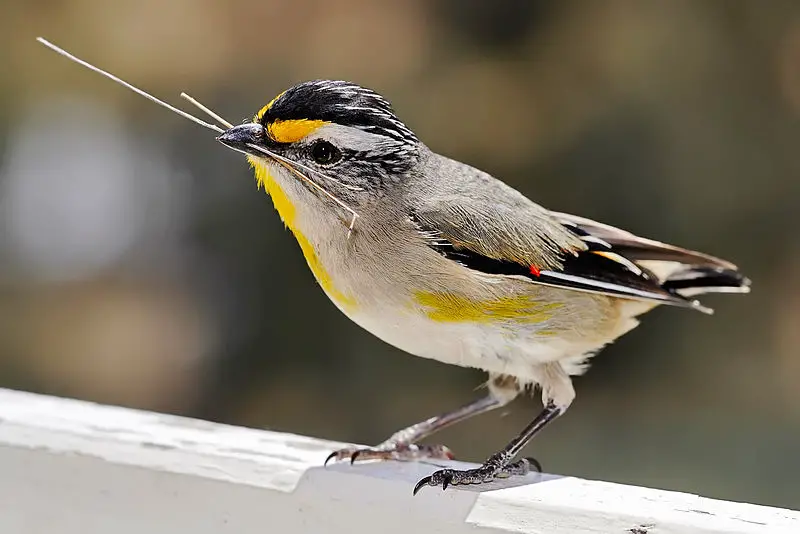
The Pardalote is a tiny bird native to Australia. It has a bright and colorful appearance, a strong build with short tails, and a blunt beak.
This bird is part of the Pardalotidae family, which includes four different species under the Genus Pardalotus.
The name of this bird comes from the Greek word “spotted”. The Pardalote’s family once had other species, which are now part of the Acanthizidae family.Scientific classification:
| Kingdom | Animalia |
| Phylum | Chordata |
| Class | Aves |
| Order | Passeriformes |
| Superfamily | Meliphagoidea |
| Family | Pardalotidae Strickland, 1842 |
| Genus | Pardalotus Vieillot, 1816 |
42. Tasmanian Thornbill
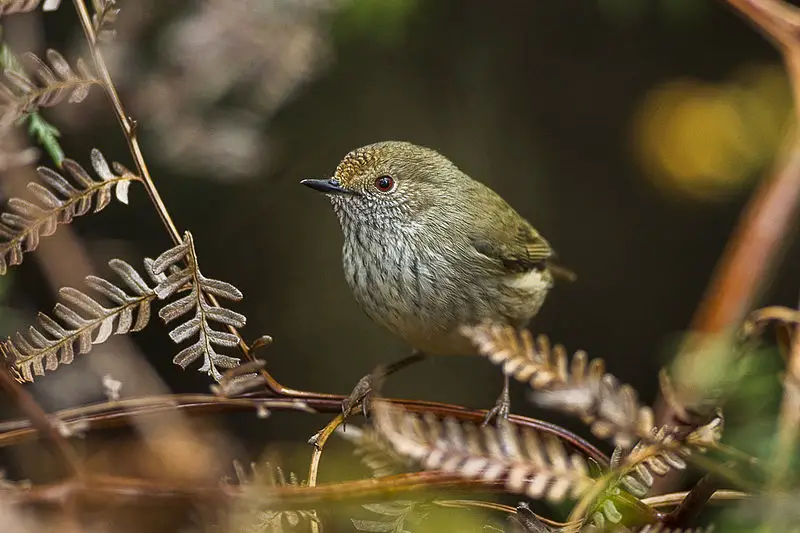
The Tasmanian thornbill is a small bird that belongs to the Acanthizidae family. It is found only in Tasmania and the Bass Strait Islands. This bird prefers cold and wet habitats, and is commonly found in these regions.
Its corresponding dry habitat is generally occupied by the brown thornbill. The Tasmanian thornbill is a frequent sight in its habitat.Scientific classification:
| Kingdom | Animalia |
| Phylum | Chordata |
| Class | Aves |
| Order | Passeriformes |
| Family | Acanthizidae |
| Genus | Acanthiza |
| Species | A. ewingii |
43. Dusky Woodswallow
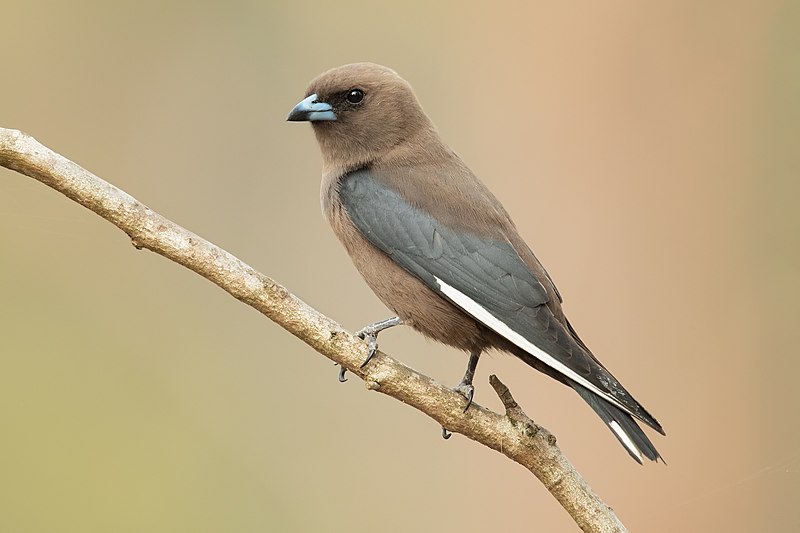
The Dusky woodswallow bird is commonly found in forests and woodlands in temperate and subtropical regions, but it can also be seen in tropical areas around the Atherton Tableland in eastern and southern Australia.
Although the global population of this bird is yet to be officially confirmed, it is ranked as “Least Concern.” The Dusky woodswallow has a unique appearance with its bluish-black head, grayish-brown back, and long, slender wings.
It feeds mainly on insects, and its diet can include ants, beetles, and flies. This bird is quite social and can often be seen perched on branches with other woodswallows in the same tree.
The Dusky woodswallow’s melodious call can also be heard across its natural habitat.Scientific classification:
| Kingdom | Animalia |
| Phylum | Chordata |
| Class | Aves |
| Order | Passeriformes |
| Family | Artamidae |
| Genus | Artamus |
| Species | A. cyanopterus |
44. Tasmanian Scrubwren
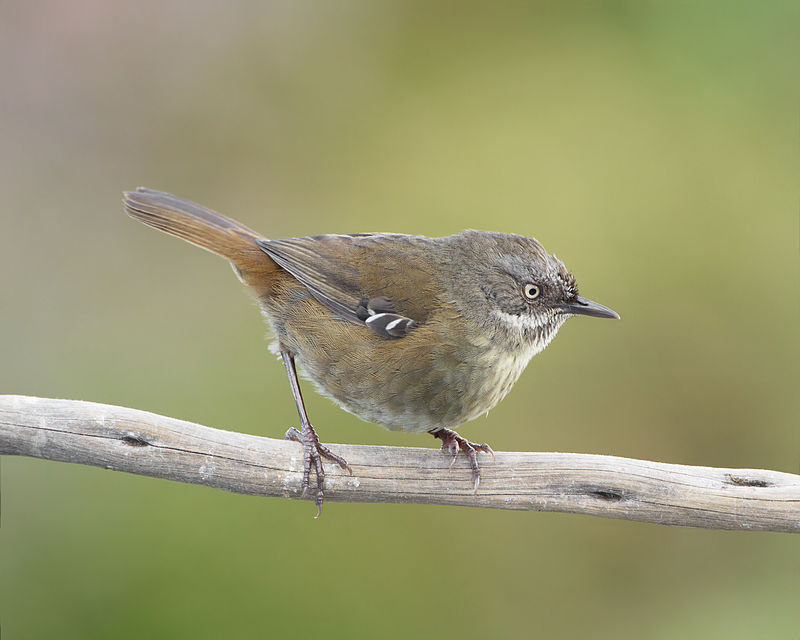
The Tasmanian scrubwren, also known as the brown scrubwren, is a unique bird species that can only be found in Tasmania and King Island.
It usually lives in the understory of various habitats such as rainforest, woodland, dry forest, swamps, and coastal scrublands.
Despite being formerly placed in the Pardalotidae family, this classification is no longer accepted.
The Tasmanian scrubwren is known for its small size and brown-colored plumage. It has a pointed bill and long tail that help it forage on the ground and climb on vertical surfaces.
This bird species is a vital player in the ecosystem, contributing to seed dispersal and insect control.
It is a pleasure for birdwatchers and nature enthusiasts to catch a glimpse of the Tasmanian scrubwren in its natural habitat.Scientific classification:
| Kingdom | Animalia |
| Phylum | Chordata |
| Class | Aves |
| Order | Passeriformes |
| Family | Acanthizidae |
| Genus | Sericornis |
| Species | S. humilis |
45. Australasian Bittern
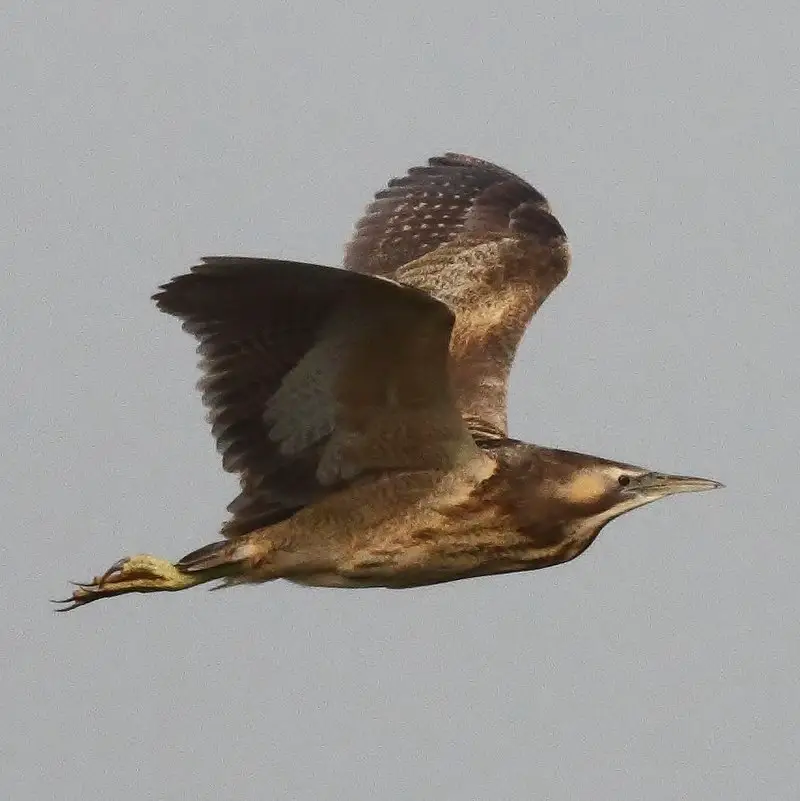
The Australasian bittern, also known as the brown bittern or matuku hūrepo, is a large bird from the heron family Ardeidae. It has a distinct booming call and is more often heard than seen due to its secretive nature.
This bird is endangered in both Australia and New Zealand, making its conservation a vital concern.
With a unique appearance and behavior, the Australasian bittern is a fascinating species to study, but its dwindling population highlights the importance of conservation efforts to protect and preserve this species for future generations.
Its nickname, the “bunyip bird,” adds to its mythical and mysterious allure among bird enthusiasts.Scientific classification:
| Kingdom | Animalia |
| Phylum | Chordata |
| Class | Aves |
| Order | Pelecaniformes |
| Family | Ardeidae |
| Genus | Botaurus |
| Species | B. poiciloptilus |
Also Featured In: Endangered Birds of New Zealand, Birds of New Caledonia
46. Red-Necked Stint
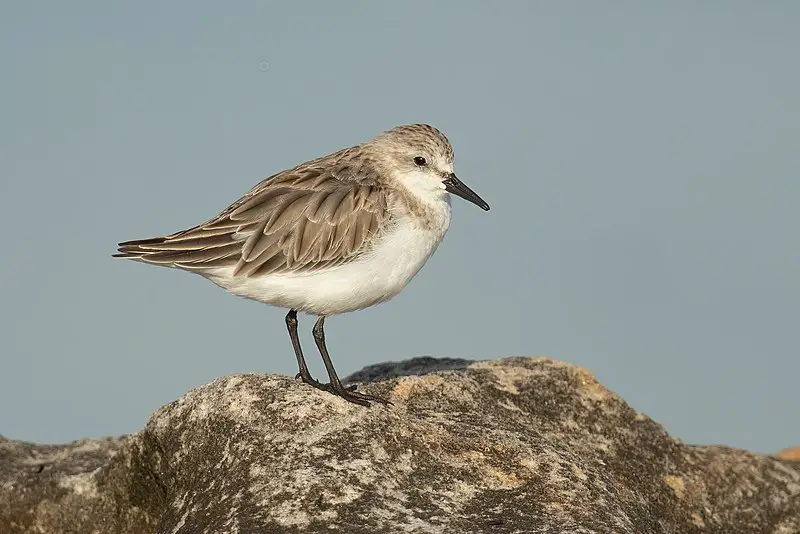
The Red-necked stint is a migratory wader known for its small size. It is often compared to the Little stint due to its similar appearance.
The bird’s genus name, Calidris, refers to grey-coloured waterside birds, according to Aristotle.
The Latin word rufus, meaning “red,” and collum, meaning “neck,” comprise the bird’s specific name ruficollis.
These tiny birds are known for their vibrant colors and are easily recognizable due to their distinct red necks.
They are also known for their remarkable migration patterns, flying long distances during breeding and non-breeding seasons.
Despite their small stature, Red-necked stints are impressive birds with a fascinating history.Scientific classification:
| Kingdom | Animalia |
| Phylum | Chordata |
| Class | Aves |
| Order | Charadriiformes |
| Family | Scolopacidae |
| Genus | Calidris |
| Species | C. ruficollis |
Also Featured In: Most Common Birds Live in Osaka, Birds You’ll Find in Hokkaido
47. Banded Lapwing
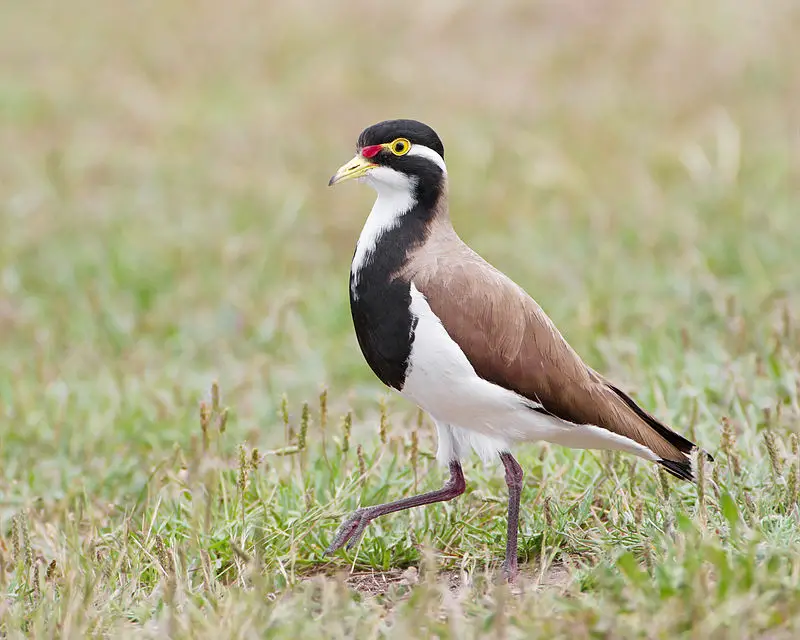
The Banded lapwing, also known as black-breasted or brown flock, is a small to medium-sized shorebird native to Australia. This bird can be found in small groups or large flocks on open grasslands, agricultural land, and open savannah.
It was once considered a game bird for hunting. The estimated population of this species ranges from 25,000 to 1,000,000.
The Banded lapwing is a ground-dwelling bird that feeds on insects and small invertebrates. It is easily recognizable by its distinctive black and white striped chest and striking red eyes.
This bird is an important indicator of the health of grassland ecosystems and plays a vital role in insect control.Scientific classification:
| Kingdom | Animalia |
| Phylum | Chordata |
| Class | Aves |
| Order | Charadriiformes |
| Family | Charadriidae |
| Genus | Vanellus |
| Species | V. tricolor |
48. Grey Goshawk
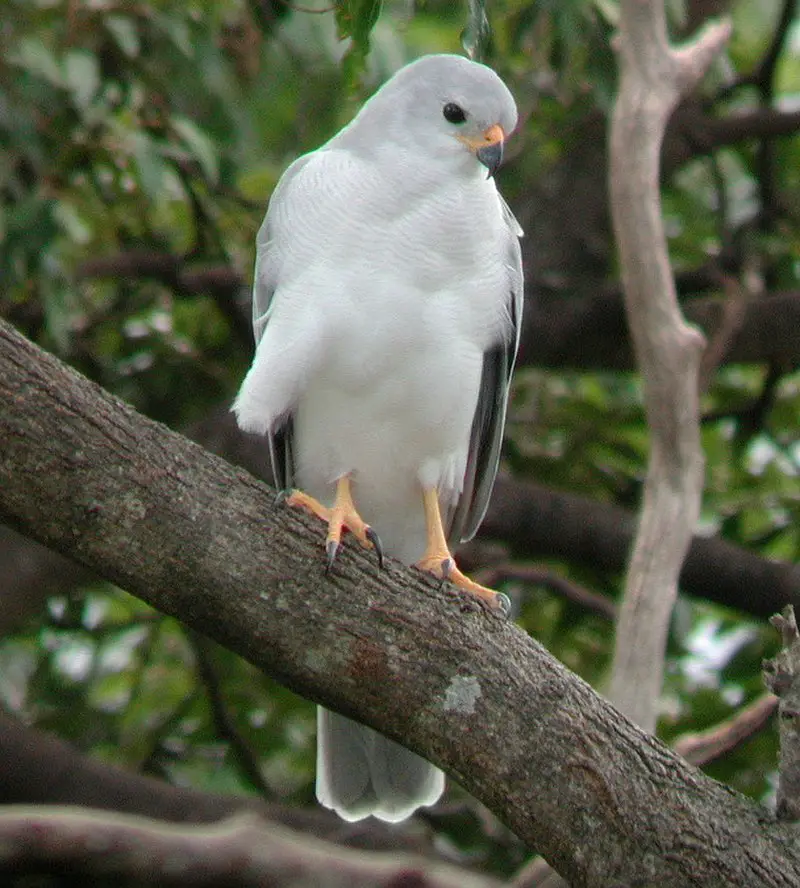
The Grey goshawk is a powerful bird of prey found in eastern and northern Australia. It belongs to the Accipitridae family and is medium-sized with a sturdy build.
A white morph of this species is also present which is called the white goshawk. This bird was first described in 1788 by the German naturalist Johann Friedrich Gmelin in the revised edition of Carl Linnaeus’s Systema Naturae.
Grey goshawks are known for their hunting skills and sharp talons. They are capable of taking down small mammals and birds with ease.
These birds have a distinctive grey plumage and bright yellow eyes. They are highly territorial and are often seen defending their territory from other birds of prey.
Grey goshawks are a remarkable display of strength and agility in the sky.Scientific classification:
| Kingdom | Animalia |
| Phylum | Chordata |
| Class | Aves |
| Order | Accipitriformes |
| Family | Accipitridae |
| Genus | Accipiter |
| Species | A. novaehollandiae |
49. Acanthizidae
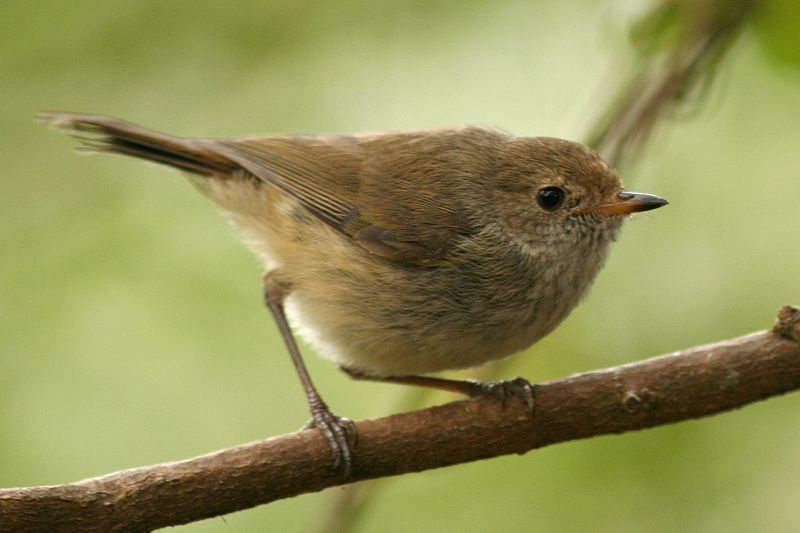
Acanthizidae, also known as Australian warblers, are small to medium-sized passerine birds. Their total length ranges from 8 to 19 centimeters. They have short rounded wings, long legs, and a short tail, with a slender bill.
These birds belong to a family that includes gerygones, thornbills Acanthiza, and scrubwrens Sericornis. Their feathers are mostly olive.
Acanthizidae are known for their beautiful songs, and they are found in a variety of habitats including forests, woodlands, and shrublands.
These birds are widely distributed throughout Australia and have well-adapted to a variety of climatic conditions. Some species are known to form strong social bonds and live in groups, while others are solitary.
Acanthizidae plays an important role in the ecosystem by controlling insects and other pests.Scientific classification:
| Kingdom | Animalia |
| Phylum | Chordata |
| Class | Aves |
| Order | Passeriformes |
| Superfamily | Meliphagoidea |
| Family | Acanthizidae Bonaparte, 1854[1][2] |
50. Grey Shrikethrush
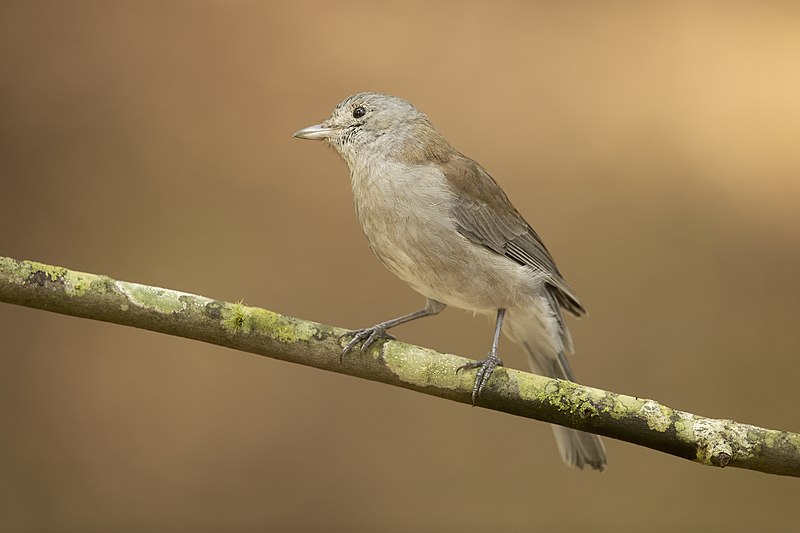
The grey shrikethrush, also known as the grey shrike-thrush or grey thrush, is a songbird native to Australasia. It can be found in most parts of Australia, but is absent from the driest areas of the inland deserts.
The bird is moderately common and is also found in New Guinea. It was originally classified under the genus Turdus.
The grey shrikethrush is often mistaken for the brown shrike-thrush due to similar appearance. They have a unique vocalization that consists of a series of melodious notes.
This bird is territorial and can be heard singing throughout the year, with peak breeding season being in August to December.
Despite being a common bird, certain regional populations have declined due to habitat destruction and fragmentation.Scientific classification:
| Kingdom | Animalia |
| Phylum | Chordata |
| Class | Aves |
| Order | Passeriformes |
| Family | Pachycephalidae |
| Genus | Colluricincla |
| Species | C. harmonica |
Also Featured In: Native Birds Of Mackay,
51. Swamp Harrier
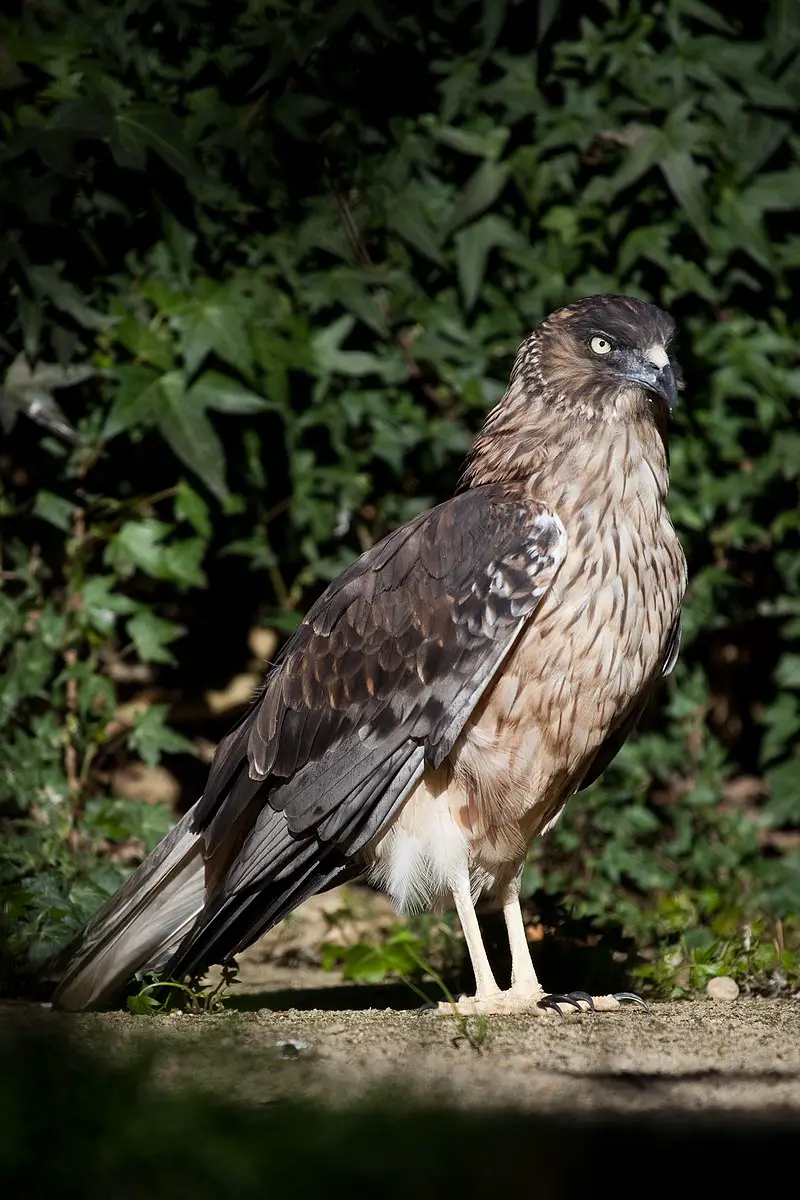
The swamp harrier bird is a predator found across Australasia. Boasting a sleek form with a wingspan of up to 1.2 meters, the bird is also known as the Australasian marsh harrier or swamp-hawk.
In New Zealand, it is called the Kāhu or harrier hawk. The bird arrived in New Zealand less than 700 years ago, replacing the now-extinct larger endemic species.
The swamp harrier bird is an adaptable hunter with a varied diet and a knack for catching prey on the ground.
Its conservation status varies across its range, but as a top predator, it plays an important role in the ecosystem.Scientific classification:
| Kingdom | Animalia |
| Phylum | Chordata |
| Class | Aves |
| Order | Accipitriformes |
| Family | Accipitridae |
| Genus | Circus Lacépède, 1799 |
| Species | C. approximans |